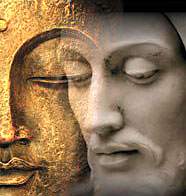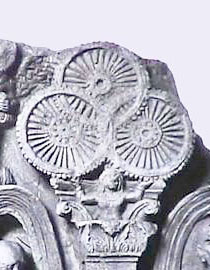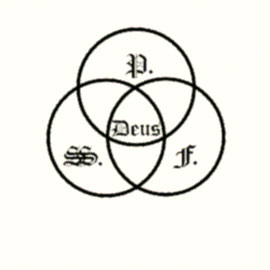|
|
CIVILIZATION AND CONSCIOUSNESS - PART I
Buddhism and Christianity seen as Civilizational Self-control
Zones
In this exploration, we delve into how historical societal
developments have laid the groundwork for enhanced living
conditions, thereby nurturing the growth of consciousness. As
previously discussed in our
chapter on
Consciousness, while the core nature of consciousness
remains largely enigmatic, we understand that aspects like
language-based cognition and the development of analytical
reasoning are central to its operation. These facets of
consciousness have been primarily cultivated within the
nurturing environments of religious institutions.
As we proceed, we will focus more closely on consciousness,
considering it as the pinnacle of humanity's neural evolution.
This advanced aspect of our neural architecture, being a recent
evolutionary development, is also our most fragile. In times of
stress, this delicate flame of consciousness can be easily
threatened. Therefore, the progress of civilization can be
likened to a series of architectural projects, constructing
systems of self-regulation that support and allow this nascent
bio-cognitive function to thrive.
On the cusp of analogy, one might contend that an intricate
network of communication and trade, as established by
civilization, reflects a more sophisticated network of neurons
within the brain. There is a tandem progression between
civilization and consciousness, each evolving and becoming more
complex in concert.
The inception of civilization saw
us evolve from beings predominantly governed by raw
instinctual awareness
to those more in tune with
consciousness. In the ensuing sections, I will adopt a
materialist-historical lens to delve into consciousness. While I
don't strictly adhere to materialism as a philosophical
standpoint, I regard it as one of the many potent tools for
comprehension.
Starting our exploration from the ice age might be tempting, but
given the sparse and often inconsistent data from that era, our
journey will commence with closer look at the trade routes
beginning at the time of the conquests of Alexander the Great.
In this context it's crucial to acknowledge that during these
times, a staggering 60% of the world's population made their
homes along these trade conduits from the Far East to the Middle
East.
My goal is to illustrate the interplay between consciousness and
civilization: how consciousness contributes to the building of
civilization, and conversely, how civilization fosters the
development of consciousness. Simultaneously, we must consider
religions and religious institutions as prime environments for
nurturing the growth of consciousness. In this exploration,
personal belief in religion is irrelevant. Even a
fictional narrative can unite us in shared realms of abstract
consciousness, demonstrating how collective beliefs, whether
factual or fictional, are able to create
a shared field of
consciousness.
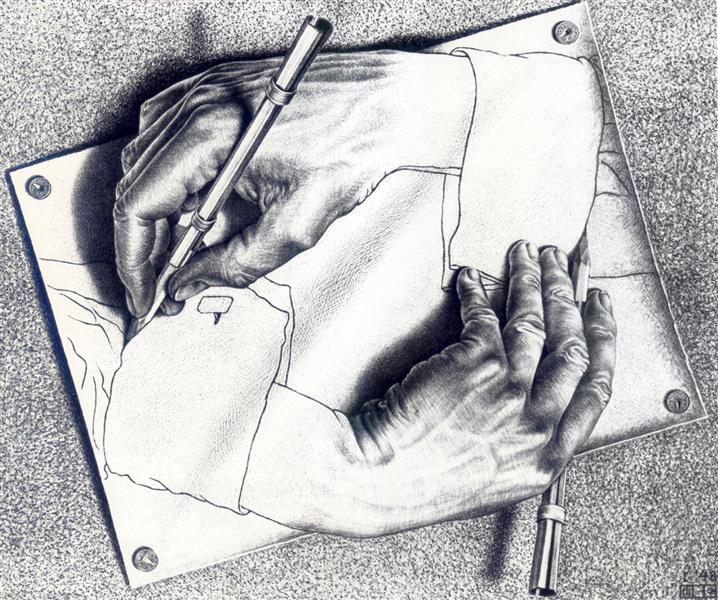
CIVILIZATION AND THE BIRTH OF
NON DUAL CONSCIOUSNESS
The Pivotal Role of Silk Routes in the Confluence of
Civilizations and Consciousness
In the crucible of interaction between East and West, both
cultures underwent irrevocable transformations that have left an
indelible impact on our world. While it might seem like a
digression to delve deeply into the unfolding of civilization in
the attempt to understand the unfoldment of human consciousness,
this significant facet of history anyhow warrants closer
attention.
The advent of human civilization and consciousness
was propelled dramatically forward with the establishment of the Silk Roads,
famously known for bridging China with Europe. Yet, the earlier trade networks
that connected India, the Middle East, and Southern Europe are often not given
due recognition. As highlighted by Giovanni Veradi, the significance of
North-western India in the realm of Buddhist and Indian studies has been largely
underestimated:
"North-western India enjoys, or rather suffers
from,
a peculiar situation in the field of Buddhist and Indian studies."
'Buddhism in North-western India and
Eastern Afghanistan'
I would venture to broaden Veradi's insight to
encompass not only religious aspects but also cultural and commercial exchanges.
Similarly, its neighbor, the
Greco-Bactrian
Kingdom, was one of the wealthiest and most influential states at its peak.
This is reflected in the title of H.G. Rawlinson's work: "Bactria, The
History of a Forgotten Empire".
In this section, I will focus my analysis on the vibrant 'trade synapses' that
linked India with the Western world, deliberately omitting China from this
discussion.
Borromean rings
of Unity
To offer a glimpse into the
forthcoming discussion let's contemplate the Borromean rings—a
symbol of interconnectedness. The sculpture on the left
illustrates the Buddhist Triple Gem: the Buddha, the Sangha, and
the Dharma, known as the TRi-RaTNaS in Sanskrit. In parallel,
the image on the right represents the Christian Holy Trinity,
termed TRi-NiTaS in Latin. These symbols, though from distinct
traditions, both convey a unity that transcends individual
elements, hinting at the profound interrelation between
civilization and consciousness we are set to explore.
Buddhism and Christianity in Mutual Co-creation
It's impossible to envision Buddhism as we know it without
acknowledging the influences of Greek thought, just as we can't fully understand
the foundations of Christianity without considering its debts to Buddhist
philosophy. As Max Müller states in "India: What It Can Teach Us," there
are striking resemblances between Buddhism and Christianity that are impossible
to ignore, particularly given that Buddhism predates Christianity by at least
four centuries. He encourages scholarly exploration to uncover the historical
channels through which Buddhism might have influenced Christian thought:
That there are startling
coincidences between Buddhism and Christianity cannot be denied,
and it must likewise be admitted that Buddhism existed at least
400 years before Christianity. I go even further, and should
feel extremely grateful if anybody would point out to me the
historical channels through which Buddhism had influenced
Christianity.
India: What it can teach us - Max Müller
In a similar vein, the statement
from Draaper's "Intellectual Development of Europe" also
acknowledges that if European ideas made their way to the far
East via the Bactrian Empire, then it's also likely that Asiatic
ideas, in turn, seeped into European consciousness through
similar channels.
If through the Bactrian Empire
European ideas were transmitted to the far East, through that
and similar channels Asiatic ideas found their way to Europe.
Draaper: Intellectual Development of Europe, I. ii.
Elaine Pagels, a British scholar of Buddhism, observes:
"Yet the gnostic Gospel of Thomas relates that as soon as Thomas
recognizes him, Jesus says to Thomas that they have both
received their being from the same source... Does not such
teaching—the identity of the divine and human, the concern with
illusion and enlightenment, the founder who is presented not as
Lord, but as spiritual guide—sound more Eastern than Western?
Some scholars have suggested that if the names were changed, the
'living Buddha' appropriately could say what the Gospel of
Thomas attributes to the living Jesus. Could Hindu or Buddhist
tradition have influenced gnosticism?... Trade routes between
the Greco-Roman world and the Far East were opening up at the
time when gnosticism flourished (AD 80–200); for generations,
Buddhist missionaries had been proselytizing in Alexandria. We
note, too, that Hippolytus, who was a Greek-speaking Christian
in Rome (c. 225), knows of the Indian Brahmins, and includes
their tradition among the sources of heresy..."
This quote provides an insightful perspective on the
similarities between certain aspects of Buddhist and Christian
teachings, suggesting a potential historical connection through
trade routes and cultural exchanges.
THE SILK ROAD AND OCRAM'S RAZOR
Despite the paucity of direct evidence conclusively
establishing Christianity as a Western adaptation of Buddhist
principles, the hypothesis merits further investigation. This
inquiry, guided by the principles of Occam's Razor, aims to
navigate through the complex web of historical, philosophical,
and cultural contexts. By applying this analytical tool, which
favors simpler explanations over more complex ones, we can
explore whether the paths of these two great religious
traditions might have intersected in a meaningful way.
Our exploration will concentrate on circumstantial evidence,
such as the historical timelines of Buddhism and early
Christianity, and the extensive network of trade routes like the
Silk Road, which facilitated rich cultural
exchanges between the East and West. This approach will
allow us to consider the possibility of ideological and
philosophical transmissions between these two regions.
Furthermore, we will delve into the intriguing parallels between
Buddhist and Christian teachings. This comparative analysis will
focus on similar ethical teachings, motifs in parables, and the
overarching philosophies present in both religions. Such
parallels, while not definitive proof of direct influence, can
provide insights into the shared human experiences and universal
truths that these religions encapsulate.
Interpretative analysis will also play a crucial role in this
exploration. We will examine how religious ideas and practices
often evolve by incorporating elements from existing beliefs and
how these adaptations are understood by various scholars and
historians. This will include a consideration of the syncretic
nature of religious development and the challenges in tracing
the origins of specific doctrines or practices.
It is important to note that while this investigation aims to
present persuasive arguments for Buddhist influences on
Christianity, it inherently recognizes the speculative nature of
such a thesis.
SPICE TRADE AND RELIGION
Since the era of Alexander the Great, a vibrant spice trade
has flourished between the Greeks and India,
symbolizing a broader exchange far beyond mere commodities. The
Silk Road, renowned for its commercial significance, functioned
as a dynamic conduit for the exchange of ideas and cultural
practices, potentially extending to the philosophical and
spiritual concepts that influenced early Christianity. The
impact of this trade is metaphorically akin to the Roman
culinary adaptation of Indian spices. The Roman Empire's spice
trade with India began following the conquest of Egypt by
Augustus in 30 BCE. This conquest opened up new trade routes and
opportunities, significantly impacting the scope and nature of
the spice trade between these two regions. The introduction of these
exotic flavors didn't lead to the Romans directly replicating
Indian cuisine; rather, it inspired a transformative fusion
within their own culinary traditions, creating something
uniquely new while retaining a Roman essence.
This analogy serves as a potent metaphor for the potential
cross-pollination of religious ideas. Just as spices subtly yet
significantly altered Roman cuisine, it is plausible to suggest
that the religious and philosophical ideas traveling along these
trade routes might have similarly 'spiced up' the religious and
cultural life in the Western reaches of these networks.
Buddhism, which had already established a wide presence in Asia
by the time of these exchanges, could have feasibly left subtle
imprints on the evolving religious thoughts in the West.
Thus, in this context, the suggestion that emerging Western
religious thought, particularly early Christianity, could have
been influenced by Eastern philosophies like Buddhism becomes a
compelling hypothesis. It proposes a scenario where the essence
of Christianity is preserved, yet it is enriched and subtly
transformed by the infusion of ideas and concepts borne along
the Silk Road, mirroring the culinary metamorphosis induced by
the spice trade.
Buddhism's Influence on Christianity: Subtle and Overlooked
The subtle impact of Buddhism on Christianity is partly due
to Buddhism's understated, decentralized spread. Its peaceful
dissemination, focused on universal moral teachings rather than
charismatic leaders, is less apparent in historical records
compared to the more overt conversion efforts of later Christian
and Islamic missions. This makes Buddhism's influence on other
religions, including Christianity, more elusive and difficult to
document.
THE FOLCLORIC SPREAD OF THE JATAKA TALES
As dusk fell upon the caravanserais connecting the East with
the West, the glow of firelight became the backdrop for
storytelling. Since the time of the Buddha, oral folkloric
spread tales evolved on the Gangetic plains. These tales are
today known as the
As twilight descended on the
caravanserais bridging East and West, the flicker of firelight
set the stage for storytelling. These tales, originating from
the Buddha's era on the Gangetic plains, are known today as the
Jataka
tales. Laden with moral teachings, they provided more than
just entertainment for travelers; they spread Buddhism's ethical
principles. This dissemination wasn't just of religious doctrine
but a universal ethos of kindness and morality, adaptable across
various cultures. The Jataka tales' universal themes of ethical
behavior resonated deeply along the Silk Road, interweaving into
diverse spiritual traditions and nurturing a rich cultural
exchange.
The Jataka tales, a cornerstone of
oral tradition, linked distant civilizations, traveling with
caravans from India to Persia and even to Scandinavia. In
Denmark, for instance, the Molbo tales, according to prefatory
notes in collections of these stories, are believed to have
roots in the Jataka narratives. While specific cultural elements
like caste distinctions didn't transfer to Danish versions, the
core storytelling principles endured. The
Danish
Molbo tales adapt these narratives, replacing the 'ignorant'
Brahmins with 'naive' Molboes, preserving the Jataka's original
narrative structures. This adaptation maintains the satirical
humor intended to evoke laughter, demonstrating how the core
structure and purpose of the Jataka tales have been retained and
localized in Danish folklore.
Holberg's "Jeppe on the Mountain": A Tale of Two
Interpretations
From oral traditions these wandering tales made their way
into litterature and drama. The Danish author and enlightenment
philosopher,
Ludvig Holberg's "Jeppe on the Mountain" serves as an
especially interesting example of cultural adaptation. According
to Kaare
Foss in "Konge for en dag" ("King for a Day"),
Ludvig Holberg's "Jeppe på Bjerget" ("Jeppe
of the Hill") serves as example of how stories adapt and
evolve across cultures and epochs. In Holberg's rendition,
Jeppe, a poor and humble man, awakens to find himself in the
luxurious circumstances of a baron. This story traces its
lineage back through various European adaptations to "One
Thousand and One Nights," a collection with Persian origins.
Even further back, the narrative can be traced to Indian Jataka
tales where the protagonist, usually a poor man, wakes up in a
palace, suddenly a maharaja (king).
The original Indian version focuses on the moral theme of
"maya," or illusion. It poses a question: are you a beggar
dreaming you're a king, or a king dreaming you're a beggar? This
foundational concept is, interestingly, lost in the earliest
European adaptations. These versions more reflect the nobility's
disdain for the aspirations of the lower classesrather than the
philosophical concept of illusion.
The moral in Holberg's unique adaptation, centers on the dangers
of role-swapping and the inadequacies of a commoner
impersonating a nobleman. Thus, the same story reflects
different cultural values and concerns when it travels.
A Complex Web of Narratives
Even
Hans Christian Andersen's famous tale "The
Emperor's New Clothes" echoes this ancient exchange. Its
moral lesson about a child's innocence piercing through social
pretense finds its parallel in Indian traditions of wearing very
fine silk, so fine that it is almost invisible.
The Emperor's New Clothes has long been cited as a
classic fable cautioning against vanity and the unwillingness to
face uncomfortable truths. In this story, the emperor, swayed by
his own vanity and the cunning of his advisors, parades naked in
the belief that he is wearing "invisible" clothes visible only
to the wise and competent.
While this story often is read as a unique product of European
folklore, it shares intriguing parallels with older traditions
traceable to the Silk Road's influence. One such connection lies
in the material said to be used for the emperor's "new clothes"
— a fabric so fine and luxurious that it appears invisible. This
aspect of the tale have roots in ancient Indian traditions
around silk clothing.
In Buddhist iconography, religious figures are sometimes
depicted wearing extremely fine silk, so delicate that it
renders them almost unclothed. This portrayal, where their forms
are subtly draped, implies that the fabric's fineness is a
symbol of spiritual significance. The concept of "shunyata" or
spiritual emptiness is mirrored in these almost non-existent
garments, creating a paradox where a dress so valuable
essentially becomes invisible, symbolizing kingly renunciation.
This juxtaposition of opposites — value and non-existence —
serves as a metaphor for spiritual enlightenment and
renunciation in Buddhist thought.
This intriguing paradox resonates through history, including
into the Mughal period. For instance, Emperor Akbar once
reproached his daughter for appearing naked before him. Her
response revealed a subtle cultural nuance: she was actually
adorned in three layers of extremely fine silk. This incident
highlights the cultural and historical continuity of the value
placed on fine, almost imperceptible silk, embodying a blend of
modesty, luxury, and the nuanced perceptions of material and
appearance in different cultural contexts.
The enduring legacies and widespread influence of these cultural
constructs demonstrate the deep interconnectivity of the ancient
world. This interconnectedness is evident both historically and
geographically, revealing a rich tapestry of cultural exchanges
that transcended regional and temporal boundaries.
Jesus and Buddha: Icons in Pan-viral Storytelling
Is Christian baptism rooted in ancient river cultures? In
India, a timeless realm, millions still perform baptism-like
rituals in the Ganges at Varanasi.
Religious ideas, like water, flow through time and space,
morphing to fit the cultural terrains they traverse. Religions
and their leaders are thus adaptive reconstructions, crafted
from pre-existing elements. Figures like Jesus and Buddha emerge
from these ideological streams, embodying humanly shaped
channels of thought.
To illustrate the
transmutation of stories across cultures, consider the tale of a
clever young man from the reign of the Indian Emperor Akbar in
the 16th Century, which later became associated with the Danish
King Christian IV in the 17th Century. In the Indian narrative,
a bright youth impresses Akbar with his wit at a crossroads and
is subsequently invited to the royal palace at Fatehpur Sikri.
Upon his arrival, he is extorted by a guard demanding half of
whatever reward he receives from the emperor. Cunningly, the
young man requests 100 lashes from Akbar, who, upon
understanding the situation, admires the young man's ingenuity
and offers him a position in his ministry instead.
In Denmark, a tale echoes this pattern with King Christian IV.
He is said to have rescued a young man who fell through the ice
between Copenhagen and Malmø. In the court, an event unfolds
reminiscent of the Fatehpur Sikri story, including a guard
confiscating the young man's diamond ring and his subsequent
request for 100 lashes. Within 50 years, this narrative, perhaps
an amalgamation of the Danish king's rescue and Akbar's tale,
evolved to depict Christian IV as a generous ruler. This
illustrates how stories like that of Jesus may have similarly
evolved through such amalgamations.
ACADEMIC EUROCENTRISM IN RELIGIOUS STUDIES
In the scholarly investigation of world religions, there
seems to be a discernible hesitancy within academia to fully
explore the interplay and influence of stories and philosophies
across different cultures. Unlike the field of world literature,
where scholars like Professor Kåre Foss readily trace literary
influences from the Gangetic plains to Scandinavia, religious
studies often exhibit a contrasting approach. This field appears
less inclined to acknowledge or investigate the potential
cross-cultural fertilization of religious ideas and narratives.
The strong resistance within academic circles to theories like
those proposed by Dr. Phil Christian Lindtner, concerning the
origins of Christianity in Buddhism, may stem from a combination
of both justified scientific skepticism and less objective
factors. While Lindtner's hypotheses might be oversimplified in
their approach, the vehement opposition they encounter points to
a deeper issue within the field. This resistance suggests a
complexity in academic discourse that transcends simple
scholarly disagreement.
It is worth questioning if institutional biases and collective
pride in Western academia might lead to reluctance in
considering theories of significant Eastern influences on
Western religious thought. This resistance could contradict
Occam's Razor, favoring simpler explanations. The challenge lies
in using the lack of evidence as a reason to dismiss discussions
about Buddhist-Christian links, especially when this absence
might stem from the same unwillingness to explore these
connections.
The teachings of Buddha, who noted the human tendency to easily
recognize others' faults while overlooking one's own, find a
parallel in Jesus' metaphor of noticing the splinter in
another's eye but not the log in one’s own. This analogy raises
a critical question about the introspective capacity of Western
academia. Are scholars in the West, like their counterparts in
other parts of the world, potentially influenced by their own
cultural and emotional biases, thus hindering a more objective
understanding of religious history?
For instance, the rise of the Hindutva movement in India and its
impact on historical interpretation by Indian historians
highlights the influence of political ideologies on academic
research. This leads us to ponder whether Western academia, too,
might be unconsciously shaped by its own cultural narratives and
biases, thus affecting its openness to theories that challenge
Eurocentric views of religious development.
This trend highlights a broader issue in Western religious
scholarship: a hesitance to fully recognize external cultural
influences. This tendency to perceive Western religious
traditions as largely self-developed extends to underestimating
the profound influence of Islamic science and culture on
European thought. Such a Eurocentric perspective overlooks the
rich tapestry of intercultural exchanges that have shaped
civilizations.
"...the task of theology (in
the university) is to make us hold unto the object of
faith...Jesus Christ, (who) goes before and lies outside the
Biblical writings......" Mogens "Menschensohn" Müller,
leading Copenhagen professor of the New Testament, in Kristeligt
Dagblad, 9-5-2014 - Quoted from Jesusisbuddha.com
In this context,
it's pertinent to observe that the academic study of religion
often presents a unique intersection where science and belief
intermingle, perhaps more than is ideal. It's rare for atheists
to deeply engage in religious studies, which may indicate that
this field, striving for scientific legitimacy, often harbors
scholars with inherent religious beliefs. This duality
potentially influences their academic pursuits, unlike in fields
like chemistry, where personal beliefs are less likely to
intersect with scientific inquiry. Thus, in religious studies,
scholars may find themselves navigating between scientific
objectivity and personal faith.
This issue is crucial in
historical and religious scholarship, where researchers'
personal beliefs and cultural backgrounds could influence their
interpretations, notably in the study of links between Buddhism
and Christianity. Take, for example,
Paula
Fredriksen, a renowned historian in early Judaism and
Christianity. Originally a Catholic, she later converted to
Judaism. This aspect of her personal religious journey offers
insight into her scholarly approach, particularly if her work
reflects a denial of Eastern influences on early Christianity.
It raises questions about whether such perspectives might be
influenced by personal religious convictions.
Often, Western scholars question the link between Christianity
and Buddhism, citing fundamental doctrinal differences. However,
the interaction between
Hinduism's Advaita Vedanta and Buddhism
demonstrates that significant differences in belief systems
don't preclude mutual influence. These traditions, despite their
distinct philosophies, have influenced each other, particularly
in metaphysical and spiritual practices.
This suggests that historical and
cultural exchanges between religions or philosophies can happen
despite significant doctrinal differences. The evolution of
religious and philosophical thought often involves a complex mix
of adopting, adapting, and sometimes challenging elements from
other systems. Thus, the argument that fundamental differences
between Buddhism and Christianity negate the possibility of
influence is not necessarily definitive. Exchange and adaptation
of ideas can coexist with, or even arise because of these
differences.
The prevalent dismissal of
Buddhist influences on Jesus by Western scholars may furthermore
stem from their general lack of proficiency in Sanskrit, Pali,
and Tibetan, as well as a limited understanding of ancient Asian
cultures.
How does one
prove that something is a copy of something else? Surely, one
must have the original as well as the copy at hand. Scholars
have failed to identify Q (the primary source) simply because
they did not consider reading MSV (Mûlasarvâstivâdavinaya) and
SDP (Saddharmapundarîka)
in the original Sanskrit. It is as simple as that. -
Lindtner,
Jesusisbuddha.com
This gap in expertise suggests a
need for a more open reception to the insights of specialists
like Lindtner, who possess extensive knowledge in these areas,
from language to history. Embracing such expertise could offer a
more nuanced and comprehensive perspective on the historical
interplay between these two great religious traditions.
The Silk Roads, as a nexus of intercultural exchange, played a
crucial role in this process, facilitating a dynamic interchange
of ideas, practices, and beliefs. They contributed significantly
to our understanding of religious developments, including the
ascetic elements within Christianity. As ideas and practices
traversed cultures, they tended to evolve and amalgamate,
forming hybrid traditions rather than direct transpositions.
Occam's Razor, which posits that the simplest explanation is
often the correct one, would suggest that the extensive network
of the Silk Roads naturally facilitated the exchange and
adaptation of religious and cultural practices. It would be an
oversimplification to assume that influences between East and
West were unidirectional or that they did not significantly
impact the religious and cultural landscapes they connected.
The responsibility of scholars, then, is to investigate why
these major trade routes did not facilitate more apparent
cultural exchanges, rather than merely attempting to prove a
direct link. The absence of such a cultural interplay along
these significant routes would be quite remarkable.
The pattern observed in Christian scholarship, where there's a
tendency to deny or overlook Buddhist influence, appears to be
repeating in the study of Greek influence in India. This
suggests a recurring theme in historical research where the
extent of intercultural influences is often underestimated or
unacknowledged.
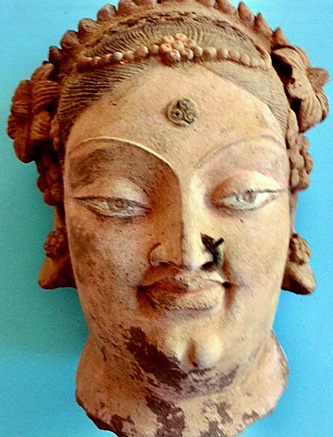
This terracotta sculpture represents a
remarkable confluence of Greek and Indian artistic traditions,
typical of the Greco-Buddhist art from the Gandhara region. The
hairstyle is elaborate, indicative of Indian artistic influence,
with curls and patterns that may reflect the sophisticated
sculptural Indian styles of the Mauryan period.
The half-closed eyes, denoting a
meditative state, are a common element in Buddhist
representations, conveying inner tranquility and spiritual
introspection. The forehead bears a third eye mark with three
rings, suggesting a connection to the Buddhist trinity, the
Borromean rings of
TRi-RaTNaS. Her elongated earlobes, another hallmark of
Buddha representations, denote wisdom and a departure from
worldly possessions.
Notably, the sculpture includes a nose ring, an adornment that
is not typically found in Greek art, suggesting a strong Indian
cultural element. This detail adds to the overall synthesis of
the figure, marrying local traditions with foreign influences.
The nose ring could signify marital status, fashion, or even
spiritual significance within Indian culture.
Additionally, the full lips, pronounced chin, and the sensual
yet contemplative expression are reminiscent of Greek sculptural
art, known for its realistic portrayal of human subjects. The
combination of Hellenistic realism with Indian symbolism results
in a sculpture that is both physically alluring and spiritually
resonant.
This piece stands as a testament to the cultural dialogue
facilitated by the Silk Road, where Greek realism met and melded
with the spiritual iconography of Indian art.
Johanna
Hanink's interpretation
of Greco-Buddhism as a reflection of European scholarly
reluctance to acknowledge native contributions to the "pleasing
proportions and elegant poses of sculptures from ancient
Gandhara," as noted by
Michael
Falser, challenges the
notion of "Buddhist art with a Greek 'essence'" as a colonial
construct emerging during British rule in India. This
perspective, as it intersects with the depiction of the Indian
woman, introduces a contentious angle in scholarly
interpretation, where the debate shifts from religious bias to
what could be perceived as left-wing political agendas. In this
light, it's not merely old European colonial perspectives
painting Indian art with Greek hues, but a modern inclination to
dismantle our colonial history under a lens of guilt. These
views, arguably 'woke,' represent another form of colonial
imposition, marked by an unrecognized Western ignorance of
Eastern history. This approach reframes cultural exchange as
cultural appropriation, seen solely through the prism of power
and dominance, further complicating our understanding of
historical intercultural interactions
The above depiction's specific features is evidence of a direct representation of
the cultural syncretism in the Seleucid Empire. This might
suggest to scholars like Hanink or Falser that cultural
intermingling was (and is) a complex, two-way process, with
influences flowing in both directions, rather than a simple case
of colonial imposition.
The overall environment of cultural synthesis provided by the
Silk Roads created an atmosphere where similar spiritual
expressions arose over thousands of kilometers. Thus, a more
inclusive historical view recognizes the Silk Roads not just as
trade routes but as channels for a dynamic cultural and
religious dialogue that has shaped the world in more ways than
is credited.
This perspective offers a valuable counterpoint to the
traditional nation-centric view of historical development. The
concept of "countries" as we understand them today is a
relatively recent development in human history, and their
borders have often been fluid and subject to change. In
contrast, trade routes such as the Silk Roads predate many
modern nations and have served as continuous channels for
interaction and exchange for millennia.
In accordance, the coming text will view trade routes as
cultural entities in their own right, fostering a level of
cultural homogeneity that might surpass that of the countries
they pass through. These routes acted as arteries of commerce,
yes, but also of ideas, religions, languages, art, and
technologies. As such, they could cultivate their own unique
cultures, which were defined not by national borders but by the
flow of goods and knowledge.
The Silk Roads as a Civilizational Zone
The Silk Roads connected a series of civilizations from the
Chinese Han Empire to the Mediterranean, creating a
supercultural zone where East and West could meet and mingle in
ways that transcended the political or cultural policies of any
single empire or nation-state along its length. The result was a
kind of Silk Road culture that, while not homogenous in the
strictest sense, shared a set of common values, practices, and
understandings shaped by the necessities of trade and the
exchange of ideas.
This perspective aligns with the concept of "cultural spheres"
or "civilizational zones," where the defining characteristics of
a region's culture are not determined by the political
boundaries of states, but by the historical, geographical, and
cultural ties that bind different peoples together. It suggests
a view of history as a tapestry woven from threads of human
interaction that are often far broader and more complex than
national narratives allow for.
The adage "follow the money" aptly applies to the Silk Road's
cultural dynamics. This ancient trade network fostered a shared
civilizational experience marked by fluidity and openness to
external influences, contrasting with the more rigid structures
of nation-states. In this context, the cultures along the Silk
Road prioritized connectivity and mutual influence, favoring a
collective development over isolation and independent growth.
This perspective underscores the significant role of trade and
economic interactions in shaping cultural and historical
landscapes.
ALEXANDER THE
GREAT IN INDIA
The key influence in the
ongoing construction of Buddhism was the introduction of Greek
philosophy. Homer was translated into Indian languages, and the
story of the Trojan Horse became part of the folklore on the
Ganges plains.
However, the influence also went the other way, as far back as
to Greece. Alexander the Great, in addition to his formidable
military skills, was philosophically inclined. His father,
Philip of Macedonia, brought Aristotle from Athens to tutor
Alexander. Alexander chose prominent philosophers
Pyrrho,
Anaxarchus,
and
Onesicritus
to accompany him on his conquest of India.
The Cultural Openness of Alexander
Generally, Greek culture was unimpressed and often disinterested
in foreign philosophies and religions. Gods of other lands were
traditionally understood not on their own terms but as locally
adapted Greek gods. Thus, the Indian god Krishna became
Hercules. From Aristotle's Macedonian-Greek perspective,
barbarians, those who did not speak Greek, were lower beings
whom the Greeks were meant to rule over. The idea of seeking
philosophical inspiration outside Greece seemed unlikely.
However, in this respect, it is of crucial importance to
mention the following: Alexander did not follow his tutor
Aristotle's opinions in this regard. The respect Alexander
showed for Persian and Egyptian culture was almost heretical in
this context, and this openness paved the way for Greek
philosophers' unusual respect and attentiveness towards India's
naked ascetics, whom the Greeks called gymnosophists. Where
Greek philosophers often provoked disgust in other cultures for
their tradition of philosophizing naked, they met in India's
ascetics a culture that practiced the same form of philosophical
nudity.
Onesicritus and the sun's naked sages
Onesicritus, a student of Diogenes, had remarkable
encounters with Indian sages, the gymnosophists. In Taxila, he
met a group of naked sages on a small hill in the scorching
midday sun. Their demand for him to undress as a condition for
discussion probably seemed familiar, as Greek philosophers also
had the habit of discussing naked. The fact that Indian sages
sat unimpressed in the burning sun and only wanted to discuss
here earned Onesicritus' respect but was not alien to a man
whose mentor was Diogenes in the barrel.
Diogenes, as the archetype of the provocative holy fool who
scornfully sat outside society's rules, would undoubtedly be
recognized by India's wise men.
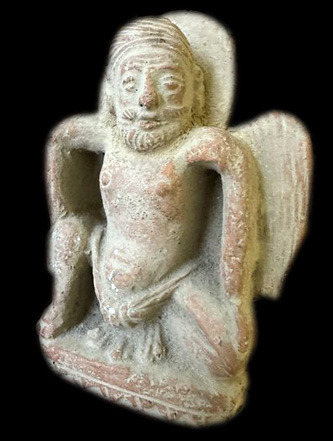
This Bactrian terracotta figurine embodies the
fusion of Hellenistic and indigenous artistic influences. The
figure's posture and stylized wings echo Greek representations
of deities and mythological figures, such as Eros or Nike. The
facial features, with a prominent beard and detailed hair,
resonate with the classical Greek style of portraying mature
male figures, emphasizing individuality and expression. The
craftsmanship and the figure's attire, including the drapery's
folds, reveal a Hellenistic touch, a common trait in the
region's iconography following Alexander the Great's incursion
into Central Asia and the subsequent cultural syncretism.
The terra cotta figure from Bactria shares several parallels
with depictions of Diogenes, the Greek philosopher: Cynic
Philosophy Representation: Diogenes is often depicted in a
simple cloak, embodying the Cynic philosophy of living in
accordance with nature and rejecting material possessions. The
figure's simple attire may reflect this philosophy. Ascetic
Lifestyle: Diogenes was known for his ascetic lifestyle, which
is also a common theme in Buddhist representations. The figure's
modest clothing and humble posture could symbolize a similar
asceticism. Beard and Hair: The detailed beard and hair are
reminiscent of classical Greek depictions of philosophers, among
whom Diogenes is one of the most iconic. Posture and Expression:
Diogenes was famous for his provocative actions and disdain for
societal norms. The seated posture and the facial expression of
the figure, which could be interpreted as contemplative or
challenging, might draw a parallel to Diogenes' own public
demeanor. Wings: While Diogenes himself was not associated with
wings, the Greek god Hermes was, and he was a messenger who
traversed between the divine and mortal worlds. Diogenes'
philosophy attempted to transcend conventional life, which could
be symbolically represented by wings. These elements combined
may suggest a fusion of Greek philosophical iconography with
local Bactrian cultural motifs, portraying a figure that echoes
the spirit of Diogenes in a new cultural context.
Visiting the sacred city of
Varanasi, one often meets Indian sadhus, modern embodiments of
the ancient philosopher Diogenes. The terracotta figure, similar
to numerous others, serves as a testament to these encounters.
These interactions, where the lifestyles of Indian ascetics
affirmed the principles of Diogenes, became ingrained in the
cultural memory of both Greek and later European societies,
honoring the wisdom of Indian gymnosophists. Subsequently,
figures such as the English Puritans recognized these sages as
precursors to their own ascetic practices.
Calanus - the army's sage
There are many indirect indicators of this compatibility between
Greek and Indian culture. That philosophers from the two
cultures could meet in dialogue is perhaps natural, but even the
ordinary soldier in Alexander's army could apparently
respectfully recognize the Indian ascetic's lifestyle and value
norms.
A naked sadhu from Taxila, named by the Greeks as
Calanus, had
just completed his obligatory 37 years as a hermit and was now
free to do what he wanted. He joined Alexander and became a
popular mascot for the army. Calanus became the army's guru,
giving satsang, i.e., teaching officers and soldiers in the army
his philosophy. The extent to which the army had taken the naked
sadhu to their heart became clear when Calanus later decided to
leave his body at the age of 79 in Susa, Persia, by burning
himself alive in a dramatic ceremony, with Alexander and his
entire army as spectators. As he was carried smiling into the
flames, he was hailed by war cries and the trumpeting of
elephants from Alexander's army. At this point, Calanus had
become the army's spiritual guide, and his death was later taken
by the army as a sign of Alexander's own too early death.
Considering the abundance of similar small terracotta figures
discovered in Afghanistan, it is plausible to speculate that the
depicted sadhu may represent Calanus.
Clearchus
The philosopher
Clearchus of Soli, probably a student of Aristotle, traveled
with wisdom from Delphi to Oxus in India and later described in
his pamphlets philosophical duels between Greek philosophers and
Indian sages, where he let Indian wisdom triumph over the Greek.
India's remembrance of Alexander
India has always understood itself through myths, through
stories.
Even today in India, there are many folk tales about Alexander,
especially his interest in India's philosophers, the wise
sadhus.
To what extent Alexander's presence has influenced India can
also be glimpsed through these still-living stories. I spent
almost a year in the Indian state of Punjab, where it struck me
how much the meeting with Alexander is still remembered by the
people. In Punjab, I heard a man put another in his place by
saying: In the end, you are no more worth than one of Porus's
elephants. King Porus's elephant army was immediately
defeated by Alexander upon his entry into India in 326.
THE SELEUCID EMPIRE
In the period following Alexander the Great's death, the
Seleucid Empire, which encompassed much of the former Persian
Empire, played a pivotal role in the cultural exchange between
Hellenism and Buddhism. It was founded by
Seleucus Nicator I (358 – 281 BC), a distinguished general
of Alexander.
The Seleucid Openness
In noting the unique approach of Seleucus I Nicator, one of
Alexander's successors, it's crucial to recognize his
continuation of Alexander's 'un-Greek' respect and openness
towards 'barbarians', conditional on their submission to his
rule.
Seleucus I Nicator was among the few generals of Alexander who
supported Alexander's deliberate policy of cultural
amalgamation. This policy notably included the mass forced
marriage of his officer corps to women from ocupied countries,
especially from Persia, but later also from India. Remarkably,
Seleucus' own marriage with the
Sogdian noble
woman, Apama,
was one of the few such cross-cultural unions that survived
Alexander's death.
This successful marriage set the
tone for a Seleucid realm that was politically and militarily
aggressive, but exceptionally tolerant in terms of cultural
diversity. The son born from this mixed marriage, Antiochus I,
was fully recognized by his father and played a significant role
as a conciliator between the Persian elite and the emerging
Hellenistic ruling class.
The Unique Geopolitical
Conditions of the Seleucid Empire
The Seleucid Empire, in terms of sheer longitudinal span,
was one of the most elongated empires of the ancient world. It
stretched over 3,000 kilometers from the Aegean Sea in the west
to the Indus Valley in the east, creating a vast territory that
connected the Greek world with the rich cultures of the Near and
Middle East and Central Asia.
The Seleucid Empire was known for its extraordinary religious
tolerance and cultural openness. Stretching from India to
Turkey, this empire provided a unique melting pot where diverse
religious and cultural ideas could intermingle, potentially
including the philosophical and spiritual tenets of Buddhism and
early Christianity. As depicted in the accompanying map, it is
quite apt to view the Seleucid Empire not just as a political
entity but as a massive trading route in itself. The Empire
acted as a bridge between the East and West, facilitating the
flow of goods, cultures, ideas, and technologies across its vast
expanse. It connected the Hellenistic world with the societies
of Central Asia and the Indian subcontinent.
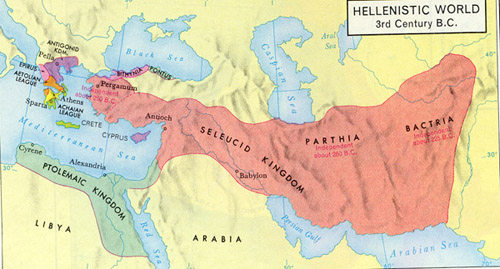
The Challenge of Ruling a Wast Territory
Unlike
Ptolemy, another of Alexander's generals who took control of
Egypt—a small but fertile part of Alexander's legacy—Seleucus
faced entirely different challenges. He ruled over a vast
territory that united diverse cultures including Sumer, Elam,
Persia, Assyria, Phoenicia, Babylon, and later Asia Minor and
Palestine. This required an exceptional ability and willingness
to collaborate culturally.
No Seleucid Racial and Ethnic Exclusivity
This reflects why Cleopatra, who was of entirely Macedonian
origin, contrasts with the rulers of the Seleucid Empire, who
were an amalgamation of various cultures and ethnicities. This
diversity among the Seleucid rulers highlights their openness to
different backgrounds, differing from the more ethnically
homogeneous leadership in other post-Alexandrian geographically
much smaller empires.
Contrary to other post-Alexandrian empires, such as Ptolemaic
Egypt, the Seleucid Empire did not have a racial exclusivity
built into the highest echelons of its power structure. In this
way, it continued Alexander's ingenious policy—a blend of
localized feudalism and meritocratic governance. This approach
allowed anyone, regardless of their non-Macedonian origin, to
join the ranks of the powerful, provided they had earned it
through merit or were of noble birth. However, a prerequisite
for membership in this new elite circle was a mastery of the
Greek language and culture.
Polis Cultures on a String from
India to Greece
Recognizing that he couldn't consolidate his power solely by
relying on pre-existing cities, Seleucus Nicator opted to build
numerous new cities from scratch. These cities were vibrant
centers of Hellenistic polis culture, infused with
Macedonian-Greek traditions and civilization. Positioned like
pearls on a string, they also served as caravanserais and linked
India to the Middle East in a cultural exchange that lasted long
after the collapse of the Seleucid Empire and its Bactrian and
Indo-Greek successors.
Cultural Diffusion and Legacy in the Seleucid Empire
In the various Alexandrias and newly-founded Seleucias that
dotted the landscape of the Seleucid Empire, Hellenistic culture
became a marker of social capital. Speaking Greek and venerating
Greek gods were not just exercises in spirituality or
communication; they became synonymous with power and prosperity.
Local indigenous groups and their leaders, even those situated
far from the traditional Greek heartland, adopted the Greek
language and partook in Greek theatrical productions as a form
of cultural assimilation that had direct social and economic
benefits.
A Second Wave of Hellenistic Migration
The formation of the Seleucid Empire facilitated a second
wave of migration, distinct from the initial military
expeditions. This time, the people who set out for new lands
were not just soldiers but commoners—artisans, scribes,
philosophers, and scientists from Macedonia and Greece. Their
journey for a better life in the newly-established cities of the
Seleucid Empire echoes the 19th-century mass migration to
America. These new settlers left an indelible, albeit often
overlooked, imprint on the cultural and intellectual landscape
of the East.
The Seleucid experiment in cultural fusion had long-lasting
implications, not just in terms of the flow of goods along the
burgeoning trade routes, but also in the spread of ideas and
traditions. It became a vibrant hub of cultural exchange, laying
the foundation for future civilizations to build upon.
The Seleucid Empire seen as a Civilizational Zone
Examining historical examples, the
Seleucid
Empire emerges as a key illustration of the civilizational
zones concept. This empire, a confluence of diverse languages
and cultures, demonstrates the intricate dynamics of cultural
and historical evolution in vast empires. Analysis of the
Seleucid Empire through the lens of civilizational zones
highlights how varied cultural and linguistic groups were
unified and interacted under its expansive rule, weaving an
intricate tapestry of interconnected histories.
Intriguingly, within this context, a form of abstract universal
goodness, akin to Buddhist principles, emerged as the lingua
franca, facilitating cohesion and communication across this vast
empire, and exemplifying the significant role of shared
philosophical and ethical frameworks in the unification of large
and diverse territories.
THE MAURYAN EMPIRE
In India itself, the rise of power centers during the
contemporary Mauryan dynasty led to the creation of wealthy
Gangetic mega-cities. This urbanization necessitated, like the
case was in the Seleucid Empire, a state capable of overseeing
long-distance trade and production. Elements of the warrior
caste evolved into a new state caste, focused on the
ever-growing need to regulate trade and infrastructure.
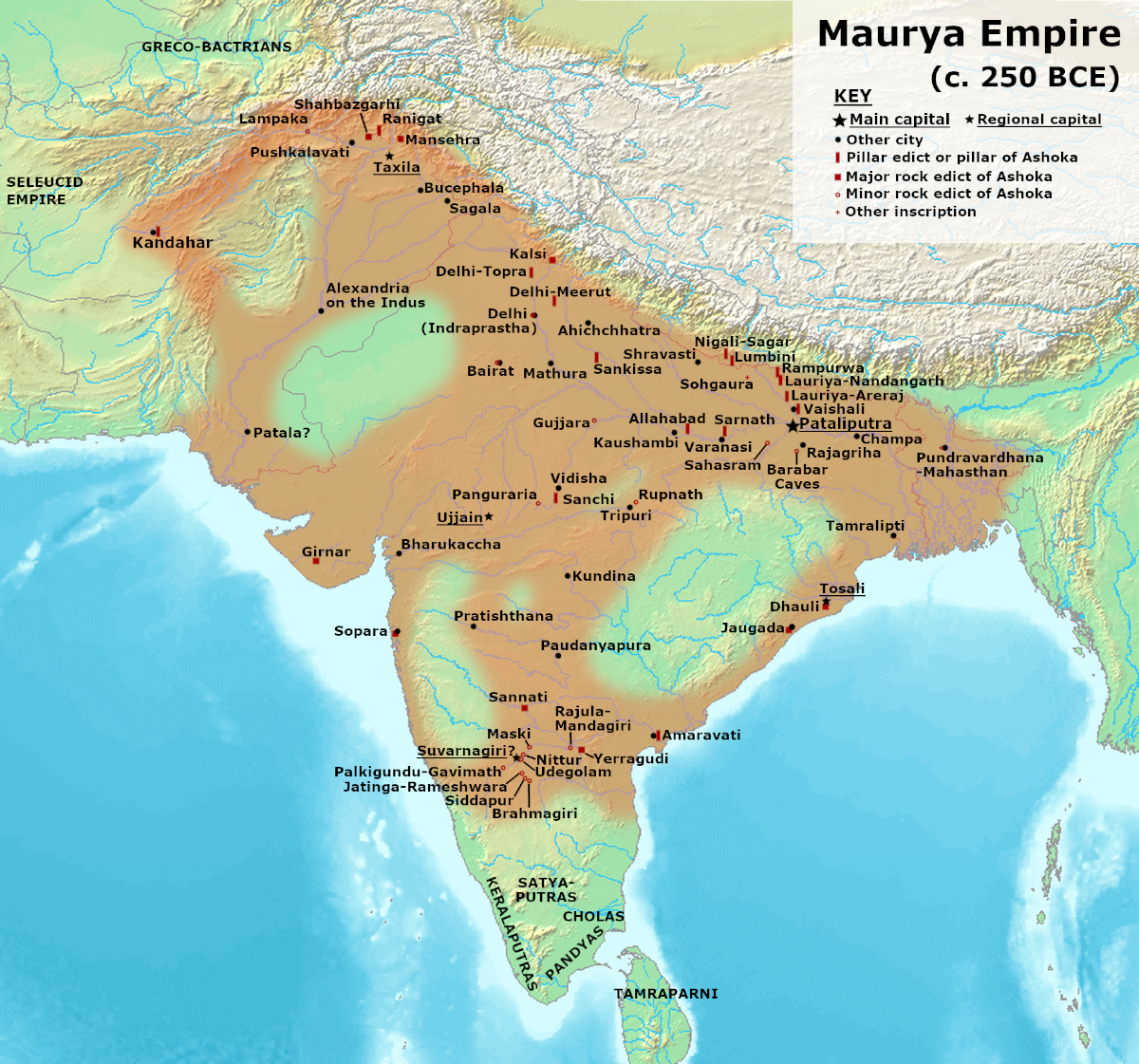
Chandragupta Maurya: India's
Great Low-Caste King
Chandragupta Maurya (340-298 BCE), the grandfather of
Ashoka, was a
man of humble origins, born into the
shudra,
the lowest caste in the societal hierarchy. Alongside
Chanakya, a
Brahmin who
felt betrayed by his own caste, Chandragupta orchestrated a
social revolution that dethroned the preceding
Nanda
dynasty. This marked the inception of the formidable
Mauryan
empire.
The Seleucid ambassador
Megasthenes
meticulously documented the Mauryan dynasty around 300 BCE while
residing at Chandragupta's court in the capital, Pataliputra—now
modern-day Patna, in the Indian state of Bihar.
Chandragupta's rise to power coincided with Alexander the
Great's arrival in Northwestern India in 326 BCE. Ancient
historians recount that Dhana Nanda, the ruler of the Nanda
dynasty, was despised in his own country for his low birth.
Alexander received emissaries from the disgruntled Brahmin caste
who offered assistance in overthrowing Dhana Nanda. However,
Alexander had to abandon his conquest plans when his own army
rebelled against marching further into India.
Both the Nanda and Maurya dynasties were led by individuals from
the lower rungs of the Indian caste system. It is plausible to
consider these low-caste dynasties as products of the social
chaos induced by the affluent cities along the Ganges and
Alexander's military disruption of the North-western region of
India.
Chandragupta's encounter with Alexander's campaign was pivotal.
The prevalence of both the Nanda and Mauryan dynasties
underscored how the emergence of Buddhism coincided with a
period of social upheaval that especially disrupted the
established caste system.
The Persian Legacy
For thousands of years, Persian culture has exerted a
significant impact on Northern India. The formidable Persian
Empire repeatedly extended its reach into the northwestern
regions of the Indian subcontinent. A testament to this
influence is the very name 'India' itself, which derives from
the Persian inability to pronounce the letter 's,' transforming
'Sindh,' a province in what is now Pakistan, into 'Hindh.' This
linguistic adaptation gave rise to the terms 'Hindustan' and
'Hindus,' underscoring the depth of Persian cultural imprint on
India.
Northern India, particularly in the period just before the rise
of the Mauryan dynasty, received significant civilizational
inputs from the most powerful empire of the time, the
Achaemenid Persia. The Persians utilized the social
fragmentation of the caste system to efficiently divide and
conquer. It is reasonable to speculate that the low-caste kings
like Chandragupta received aid from Achaemenid Persia, which
sought buffer states along its eastern borders.
Chandragupta's realm was situated in what is today the state of
Bihar, a region that has retained a stronger Persian influence
than any other Indian states, an influence that is still evident
today.
Chandragupta and Chanakya's military strength could only have
originated from Persian military forces, particularly the
fragmented units that roamed into India during the chaos
following both Alexander's conquests and later his death.
Once Chandragupta had consolidated power, he modeled his
governance after Persian prototypes, even positioning himself as
an Indian replica of a Persian king. Numerous examples
illustrate the Mauryan dynasty's flirtation with Persian
culture. Chandragupta even had a cadre of female Amazonian
warriors, much like his Persian contemporaries. Early
administrative scripts in India also owe a debt to Achaemenid
Persia. Chandragupta's palaces were also constructed in
accordance with Persian prototypes. Reflecting on the ruins of
the Mauryan palaces in Patna, Rowland notes:
"The first indication of the
tremendous influence exerted on Mauryan India by the art of the
Achaemenid Empire ... the conscious adoption of the Iranian
palace plan by the Mauryas was only part of the paraphernalia of
imperialism imported from the West."
We might surmise that
Chandragupta, being an outsider to the Indian caste system, felt
little obligation to continue the cultural traditions of his
predecessors, making it easier for him to build his ideology and
power structure from an eclectic perspective.
Thus, Chandragupta Maurya was not just a great king who ascended
from the lowest echelons of society; he was a transformative
figure whose rule was significantly influenced by external
cultures, particularly Persia, which allowed him to challenge
and overturn the traditional caste hierarchies in India. This
overturn pawed the way for long-distance trade and urban life to
flourish.
THE MAURYAN-SELEUCID PEACE AGREEMENT
An important condition for the caravaic expansion was the
good relations between the Seleucid and the Mauryan empire.
Following Alexander the Great's conquests, the Seleucid Empire,
among the most influential successors, adopted a strategy of
guardedness towards the west but showed an inviting openness
towards the east. It's in this eastern realm that they
encountered the Mauryan Empire.
The unique survival strategy of the Seleucid Empire hinged on
Seleucus I Nicator's remarkable ability—honed in the days of
Alexander the Great—to build cultural bridges which again
translated into trading bridges. The turning point for the
empire's destiny was its encounter with India. Originally
beginning as a military confrontation in 305 BCE, it evolved
into a harmonious cultural exchange with the powerful Maurya
Dynasty. As a symbol of peace and friendship, Seleucus arranged
the marriage of his daughter to Chandragupta Maurya, forming an
alliance that would last for generations. In this exchange,
Seleucus ceded territories up to the Hindu Kush mountains, while
receiving 500 war elephants in return. These elephants later
proved to be a decisive force in the pivotal
Battle
of Ipsus
in Turkey in 301 BCE. The Seleucid strategy henceforth involved
peace towards the east and war to the west.
Chandragupta, aligned with the social openness of Seleucus
Nicator, granted Greeks in Kandahar the right to marry into any
Indian caste, highlighting a softened stance towards the
Brahminical caste system during the Mauryan period.
The peace treaty had a profound
impact on the later rise of the Ashokan-Mauryan Dynasty as the
world's first and largest "peace empire." Shielded by his
Macedonian friends to the northwest, Ashoka could safely convert
his empire to the non-violence of Buddhism, even implementing
laws for animal welfare. Without the predeceding Seleucid-Maurya
alliance, Ashoka's benevolent rule and the expansion of Buddhism
would have been impossible.
The Mauryan Openness versus the Exclusiveness of the Brahmans
The Brahmans, traditional custodians of Indian knowledge,
exhibited a reluctance to engage with foreign cultures, as
captured by Sir William Jones' observation that the Brahmans
seldom borrowed from Greeks or Arabs:
The Brahmans are always too proud to borrow
their
science from the Greeks, Arabs or any nation of the
Mlechchas as they call those who are ignorant of the Vedas.
Yet, the cultural panorama had
changed in India under the Mauryan Empire. Brahmins were loosing
power. Chandragupta Maurya, having interacted with Alexander's
Greeks, appreciated Hellenistic influences. His disruptive
Persian ouview together with his lower cast background pawed the
way for curiosity and social experimantation. Chandragupta's
religious outview was furthermore rooted in Janism, an Indian
minority religion that lived outside the laws' of
Manu's cast
system.
At the previous mentioned peace agreement in 305 B.C.,
Chandragupta's acquisition of territory up to Hindu Kush, also
incuded the annexation of the Greek city of Alexandria Arachosia
(modern-day Kandahar or Gandhara in Persian) Chandragupta
allowed it to flourish under Hellenistic ideals.
Cultural Synthesis
The Seleucid-Indian friendship led to the flow of Indian
wisdom into the Seleucid Empire, while Hellenistic wisdom
enriched Northwestern India. In this cross-cultural melting pot,
new Greco-Indian syncretic religions began to emerge, most
notably Buddhist culture blending harmoniously with Hellenism.
Kandahar became an important center of cultural fusion. This
city and the smaller cities around it, rich in Hellenistic art
and architecture, became significant nexuses between Indian and
Hellenistic culture.
Lasting Impact from the first Seleucid-Indian Alliance
The Mauryan ethos, free from the constraints of caste,
readily imbibed Hellenistic influences, as seen in evolving
Indian statuary and art. Centuries after Alexander, Greek
statues of Zeus, Odysses and Pericles were seen alongside
various depictions of Buddha and Indian Gods.
The cross-cultural friendship ensured that the Mauryan Dynasty
would maintain a cordial diplomatic relationship with the
Seleucid Empire. Seleucus sent an ambassador named
Megasthenes
to Chandragupta's court in Pataliputra. Successive Mauryan
rulers like
Bindusara
and Ashoka continued these diplomatic relations through exchange
of ambassadors.
Though the sprawling Seleucid Empire was eventually replaced by
a series of smaller Greek states, the original Greek-Indian
alliance significantly shaped the region from India to the
Middle East for centuries.
ASHOKA THE GREAT
It is indeed remarkable how the influence of one of the
world's largest empires has been overlooked in Western
historiography. Only the author H.G. Wells seems to afford
Ashoka the
recognition he deserves, stating:
"His (Ashoka's)
reign for eight-and-twenty years was one of
the brightest interludes in the troubled history of mankind."
In the era preceding the end of
the Punic Wars, which heralded the rise of the mighty Roman
Empire, and after Macedonia had lost its leading role with the
death of Alexander the Great, a new and powerful India emerged.
This resurgence was fueled by flourishing trade, skilled
craftsmanship, and agriculture.
Ashoka,
the grandson of Chandragupta Maurya, is revered as one of the
greatest and most enlightened rulers in Indian history. His
reign marks the zenith of the Mauryan dynasty. Initially known
as "Ashoka the Terrible" in his impetuous youth, he was a
ruthless warlord who expanded his territory while orchestrating
a brutal campaign against Brahmins and Buddhists alike. The
bounty for a severed head of a Brahmin was a staggering 100
dinars.
However, Ashoka underwent a profound transformation after
converting to Buddhism. His rule brought peace, order, and
systematic governance to a vast Indian empire that stretched
from southern India to Burma in the east and as far west as the
eastern parts of Persia.
Following a period of extreme violence, including the
devastating
Kalinga war, Ashoka's empire metamorphosed into the world's
first humanitarian superstate. He crafted a realm that thrived
through wisdom and moral authority rather than the force of the
sword.
Ashoka's governance followed a pattern that would later become a
historical archetype for warlords who, after
consolidating their power, ushered in long periods of peace
and prosperity.Inheriting the Mauryan dynasty's liberal
policies, inspired by Persian governance, Ashoka allowed social
mobility based on merit, rather than caste or religious
affiliation. While the caste system remained in place, it lost
the rigidity that characterized it before and after this period
in Indian history. Ashoka's transformative reign remains a
pivotal chapter in Indian history, highlighting the enduring
impact of ethical leadership and the unifying power of shared
humanitarian values.
Long-distance Infrastructure
A key factor in the rise and consolidation of this expansive
empire was the construction of an elaborate network of roads.
These roads acted as the lifeblood of the empire, connecting
India's multi-ethnic and multicultural tapestry into a cohesive
unit.
In this period the trade routes expanded to such an extent that
it became impossible to guard them against attacks through state
governed policing power. Ashoka 'realized' that control over the
mind is much more efficient than control over the body when it
comes down to the securing of peace in inter-dependent trading
mega-cities. Hence Buddhism became suitable as a state religion.
The Rise of
Ashoka-Buddhism
Before Ashoka, Buddha was regarded as not much more than a
local hero among hundred other saints on the Gangetic plains.
However, under Ashoka's reign, Buddhism entered an unprecedented
period of expansion. Despite its limited spread and influence in
the first few centuries after Buddha, it wasn't until Ashoka's
conversion to Buddhism around 250 BCE that this religion gained
significant momentum. This momentum eventually propelled
Buddhism into becoming one of the world's major religions.
During this period Buddhism transformed into a pragmatic state
religion. The individual quest for Nirvana took a backseat to a
state-sponsored moral doctrine. This doctrine was particularly
tailored for the prosperous city-dwellers, merchants and
artisans, keeping in mind the diverse feudal mini-states that
made up most of India at the time.
With Ashoka's conversion, a global dissemination of the
revolutionary and still-relevant teachings of the Buddha began.
Ashoka initiated a large-scale missionary effort based on
Buddha's own call for spreading the faith, a mission anchored in
the power of example:
"Oh Monks! Travel far and wide
to benefit many, out of compassion for the world, for the
advantage of gods and mortals alike. And let not two of you take
the same route. Preach the doctrine that leads to goodness.
Preach it in spirit and in letter. Show through your own
immaculate lives how religious life ought to be lived."
(Buddha)
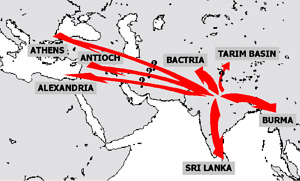
Buddhism's missionary routes
In Ashoka's version of missionary
Buddhism, the focus lay on practical tenets for everyday living
rather than intricate philosophical discourse or deification of
the Buddha. The teachings emphasized the essence of the
philosophy over the personage of the Buddha himself.
The Universities of Taxila and Nalanda
During Ashoka's peaceful reign, the early formations of
university culture began to surface. Taxila, a city that
flourished in this period, became a global center for
intellectual thought. Frequently referenced in
Buddhist Jataka tales, Taxila exemplifies how intellectual
and spiritual ideas managed to permeate all levels of society.
The city symbolized the inclusiveness of Buddhism under Ashoka,
uniting elite and commoner through shared spiritual practices.
Similarly, Nalanda University in the vicinity of Patna would
later take up the torch, profoundly shaping Buddhism even up to
the Gupta era.
The Ashokan Pillars
Inspired by Persian aesthetics, Ashoka erected towering 15-meter
sandstone pillars across his kingdom. Some were adorned with
four lion heads symbolically
proclaiming the Buddha's teachings of Dharma in all directions.
These pillars were engraved with easily digestible moral
principles, as encapsulated in Ashoka Pillar Edict Nb2 (S.
Dharmika):
"Dharma is good,
but what
constitutes Dharma?
It includes little evil, much good, kindness,
generosity, truthfulness and purity."
Ashoka Pilar Edict Nb2 (S.
Dharmika)
In an unprecedented move, Ashoka
also had his edicts inscribed in impeccable Greek, targeting
regions under Hellenistic control.
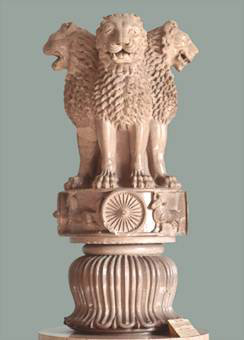
No Personality Cult
Ashoka's edicts made no mention of Buddha, and there wasn't a
single statue of Buddha from that time. The edicts emphasized
practical life rules rather than theology. With the combined
force of Ashoka's visionary Buddhism and the state's power, what
might be termed the world's first secular state was born.
The state adopted a rational form of Buddhism, viewing it as an
"enlightened" means of socio-spiritual regulation for life along
trade routes and within cities. The growth of trade routes
depended on wast geographic higway shaped areas of peace and
trust, for without them, long distance trading caravans, often
traversing hundred of kilometers without sufficient policing
infrastucture risked robbery and collapse.
Emperor Ashoka, a paramount figure in the proliferation of
Buddhism, is credited with the establishment of 84,000 stupas
and a multitude of monasteries across his empire, strategically
placed within bustling trade hubs to maximize their influence
and accessibility. This monumental effort was not confined to
his domain alone; evidence of such Buddhist structures extends
as far as Persia and even Syria. Theravada texts from Sri Lanka
notably mention a significant presence of Buddhist monastic
communities in Syria, indicating the widespread reach of
Buddhism during this period. This cross-cultural expansion
reflects the far-reaching impact of Ashoka's missionary
endeavors, disseminating Buddhist teachings well beyond the
Indian subcontinent.
The Spread of Ashoka-Buddhism
Edicts on pillars, stupas, academic institutions, and
state-endorsed monasteries and missionaries, all played a part
in the spread of Ashoka's practical moral teachings. This ethos
of self-regulation was gently impressed upon both the caravan
travelers and urban dwellers alike. Under Ashoka's guidance,
Buddhism flourished, contributing to what could be considered
the emergence of the world's inaugural secular governance. It
became the civilizational adhesive that united a diverse
populace, facilitating trade and communal harmony across vast
expanses.
In this sense,
Ashokan monasteries were not just religious retreats; they were
training grounds for self-discipline, while the wandering monks
were the deliverers of moral guidance. Ashoka's interpretation
of Buddhism provided a progressive blueprint for complex
long-distance societal organization, promoting sustained trade
and urban collaboration. In the era of Ashoka, monasteries
became centers for cultivating discipline, and Buddhist monks
emerged as devilery men of the 'dharmic interface'.
Ashoka's 'Buddhification' of Hellenistic Rulers
Under Ashoka's reign, the intermingling of Greek and Indian
philosophies reached unparalleled heights. Notably, some of
Ashoka's first converts to Buddhism were
his Macedonian-Greek neighbors in the Northwestern regions.
Although Western history often understates this, Hellenistic
rulers possibly leaned towards, or even embraced, Buddhist
tenets. The 13th Edict by S. Dhammika lists several Greek kings,
with precise historical and geographical references, as
proponents or followers of Buddhism:
Antiochus II Theos, 261–246 BC - Seleucid Empire
Ptolemy II Philadelphus, 285–247 BC - Egypt
Antigonus Gonatas, 276–239 BC - Macedonia
Magas, 288–258 BC - Cyrenaica, current-day Libya
Alexander II, 272–255 BC - Epirus, Northwestern Greece
While it's possible that Ashoka may have embellished the extent
of these monarchs' conversions, the actual process of adopting
Buddhism during that period did not require elaborate rituals.
Therefore, it is likely that the said kings merely endorsed or
showed favor towards Buddhist tenets. This, however, underscores
the notable interactions and cultural exchanges between the
far-flung eastern and western boundaries of the vast Seleucid
Empire. A critical takeaway is that, even if Ashoka's claims
about the spread of Buddhistic conversion to distant regions
like Macedonia and Greece were overstated, Buddhist ways of
thinking were nonetheless recognized in these lands.
Considering the non-aggressive and broadly relatable essence of
its teachings, it is plausible to deduce that Buddhism cast a
significant sway far beyond its core region. To employ a
contemporary metaphor, Buddhism functioned akin to open-source
spiritual-behavioral software, notable for its remarkable
capacity to be tailored,customized, by its adherents.
THE GRECO-BACTRIAN KINGDOM AND THE BUDDHIST KING MEANDER
The Greco-Bactrian Kingdom, dating from around 256 to 125
BCE, was located in what is now Afghanistan, as well as parts of
modern-day Pakistan, Tajikistan, and Uzbekistan. The climate of
this region during the time of the Greco-Bactrian Kingdom was,
backed by indirect evidence, likely more hospitable and fertile
than it is today, which would have supported the kingdom’s
immense prosperity.
Around the time of the fall of the Maurya Dynasty in 190 BC, the
Seleucid Empire began to slowly disintegrate, primarily due to
conflicts with the emerging Parthian Empire. Interestingly, the
Parthians adopted the Greek culture they observed in the
Seleucids. Even after the fragmentation of the Seleucid Empire,
the eastern satrap-kings maintained a good relationship with the
Mauryan Dynasty. The Bactrian satrap, before its independence in
255 BC and which represented the easternmost part of the
Seleucid Empire, had particularly strong ties with neighboring
India.
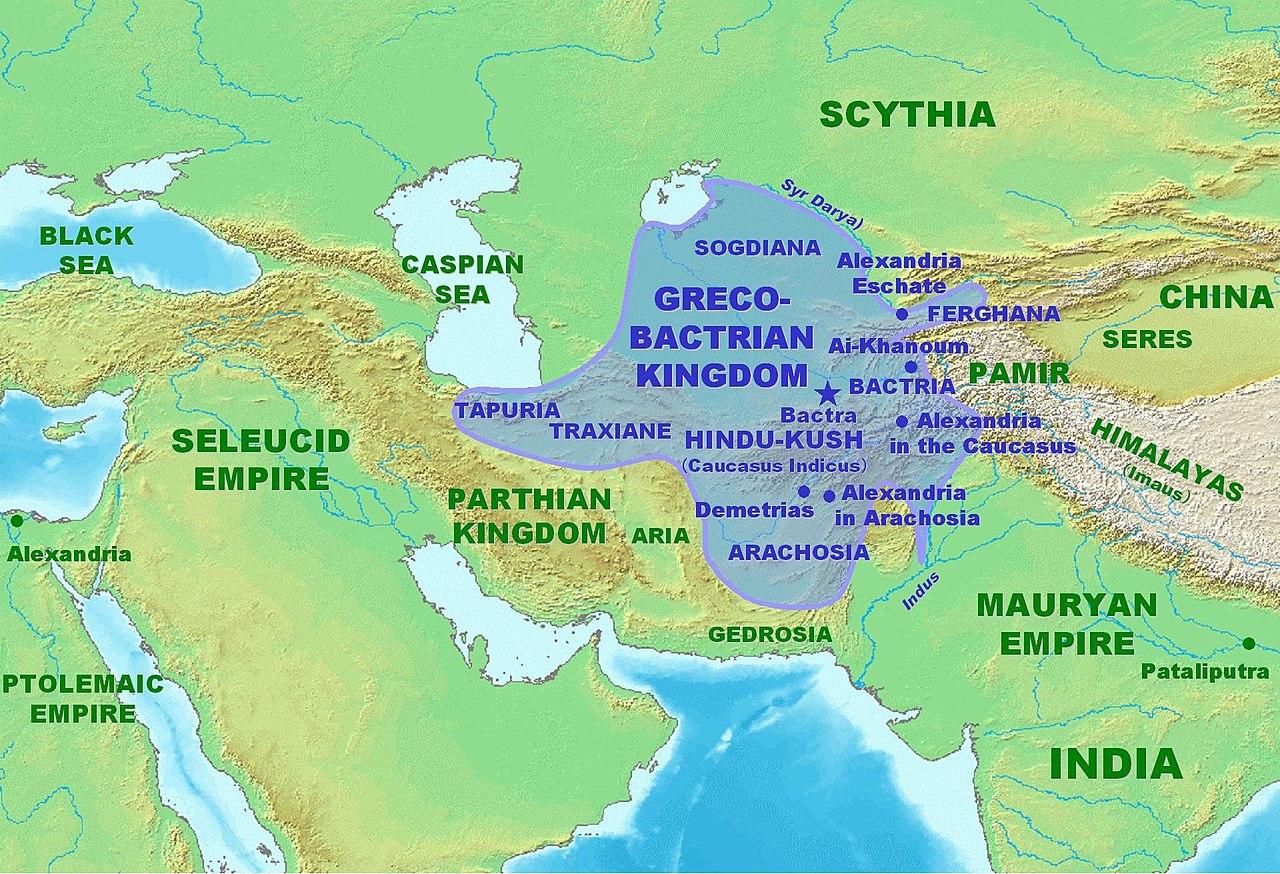
In 245 BCE, Diodotus I, a
Greek-Macedonian king, broke away from the Seleucid Empire to
establish his own state, Bactria. Concentrated with Greeks and
Macedonians, this region became a destination for political
exiles, much like Australia for England and Siberia for Russia.
Bactria continued and deepened the friendly relationship with
India, while focusing on defending against the constant
invasions from nomadic tribes to the north and northwest.
Subsequently, the King of the newly founded Bactrian kingdom,
Menander
(Melinda)
(r. 160-135 BC), emerged as one of the most
renowned converts to Buddhism.
Ruling around 150 BC, he governed
a territory spanning from Bactria (modern-day Afghanistan) to
parts of what is now northwestern India.
It is critical to highlight that the Buddhism Menander embraced
was significantly influenced by Hellenistic culture, having
undergone nearly a century of cultural interchange.
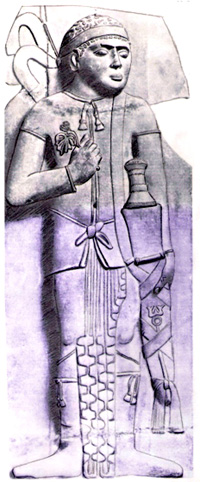
This relief from Orissa represents a Bactrian king, likely
Menander. The trinity symbol on his sword represents the Triple
Gem (Buddha, Dharma, and Sangha) in Buddhism.
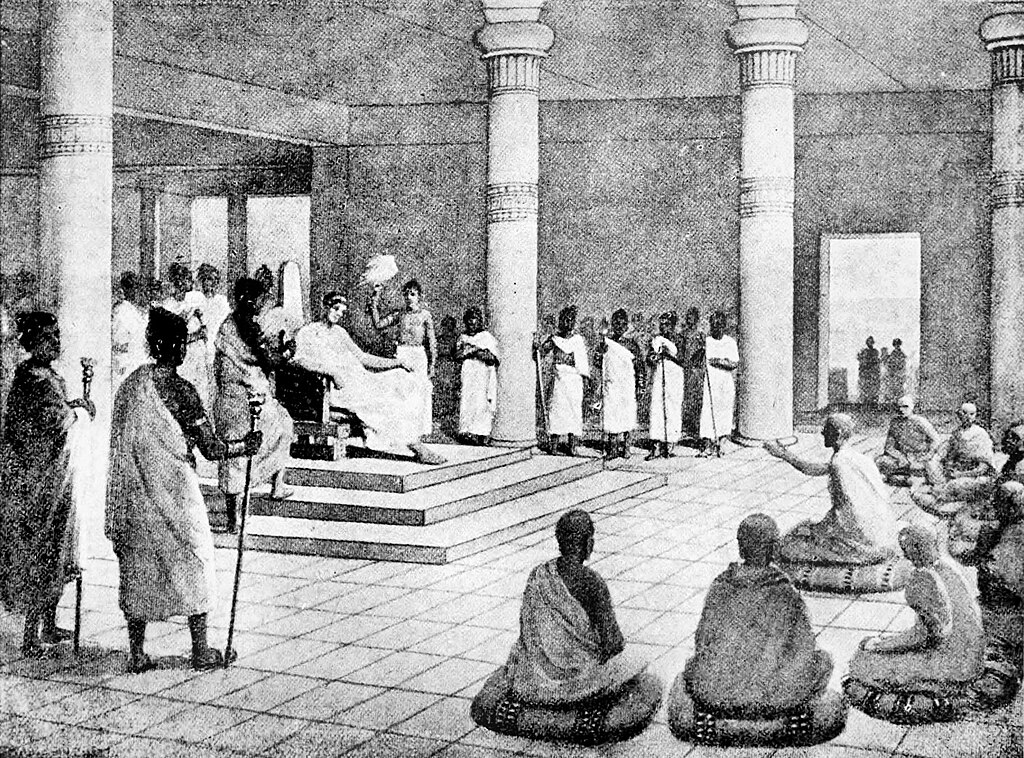
King
Meander/Melinda pose questions to his Buddhist teacher, Nagasena
During Menander's Greco-Buddhist
era, the Indo-Greek cultural synthesis reached an unprecedented
zenith. Notably, many valuable Indo-Greek artifacts in silver
and gold have been excavated. This, combined with the exquisite
coinage—which artistically surpasses even that of
Greece—indicates societies of great prosperity.
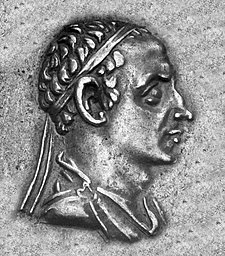
Portrait of King Meander/Melinda from a coin
Meander's predecessor, Demetrius I, had around 184 BC embarked
on a bold conquest deep into India. Here he founded the Indo
Greek Kingdom, where the Greeks even reached the new
Sunga
stronghold in
Pataliputra.
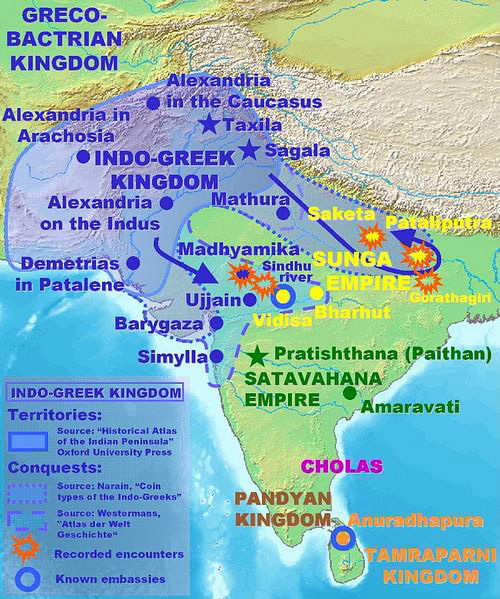
After this Eastern expansion
Taxila became
the new nexus for Greco-Buddhist religion and art. The outcome
of this conquest was that approximately 30, often rivaling,
Greek minor kings later settled and ruled in the Punjab region
that is now bith in Pakistan and India, continuing until about
50 AD. Many of these kings converted to or were sympatic towards
Buddhism. Little would be known about them if not for the
high-quality coins they left behind.
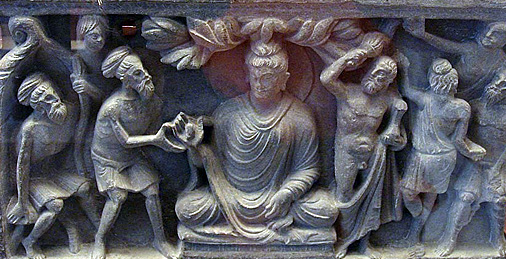
Herculean depiction of Vajrapani (right), as
the protector of the Buddha,
2nd century AD Gandhara, British Museum.
Wikipedia
The Lingua Franca of the Mudras
As diverse cultures intersected along the Silk Roads, the
barrier of spoken language was significant. However, the silent
language of the Buddha's hand gestures, or mudras, provided a
common ground. Travelers and traders, often confronted with
stupas, also encountered the ubiquitous depictions of the
Buddha, whose mudras transcended linguistic divides. These hand
gestures evolved into a form of universal communication,
enabling the exchange of Buddhist stories and teachings across a
mosaic of cultures.
It is certainly plausible that travelers on the Silk Roads could
have adopted a simplified form of mudra-inspired sign language
to convey peaceful intentions and other basic concepts to one
another. Given that the mudras were widely recognized symbols
associated with peace and spiritual ideals due to their
connection with Buddhism, they could have served as a basis for
a rudimentary, non-verbal means of communication. This form of
sign language would have facilitated basic peace assurances
among people of different languages and cultures, promoting
mutual understanding and cooperation in the diverse environment
of the Silk Roads.
Buddha's Aspirations and Civilizational Impact
Indeed, the Buddha's intent was not the construction of
grand civilizations. Yet, his profound insights and doctrines
undoubtedly assisted Emperor Ashoka in nurturing and advancing
the expansive civilization along the Ganges, and its influence
extended even further.
Buddhism's Middle Path as a
Cultural Modus Operandi
Through the rich cultural exchange, the Buddhist Middle Path
transcended its spiritual origins to become a behavioral
standard for the burgeoning merchant classes, from the Far East
to the Middle East. This ethical framework likely extended along
a buffer zone surrounding major trade arteries, influencing and
being practiced by communities within this radius. The teachings
of the Buddha on moderation began to shape a collective
consciousness, fostering a culture of restraint that was crucial
for peaceful, long-range trade.
Mind Control instead of Military Control
Instead of securing the trading routes and cities with
military power, Ashoka built self-control interfaces in the form
stupas and monasteries, not in faraway places but as close to
ordinary social life as possible where it could have a direct
impact on the ground reality.
Non-violence and Wealth
Wealth based on global trade and not localized farming is
always met with the challenge of synchronizing different
cultures living far away from each other. Without a common
denominator, trade is not possible. With the rise of the new
globally connected urban megacentres on the Gangetic plain,
Buddhism evolved as an understanding of reality that could unite
people of different casts, creeds, and cultures in both urban
and 'caravanic' self-control. Here the feudal Brahmanistic cast
fragmentation would not be able to make ends meet. Hence
Buddhism evolved into a self-restraining and peace-producing
Buddha-belt from East to West. Without religious implemented
self-control, the long-distance silk routes would as mentioned,
collapse into banditry, and without the same, people of
different colors, creeds, and languages would not be able to
co-exist in big cities and in the caravanserais placed along the
caravan routes.
East-end Buddhism and West-end Cristianity
The influence of Ashokan Buddhism is reflected in the
Western emergence of Christianity. With the decline of the Roman
Empire's military prowess, Christianity rose as the predominant
ideology for self-regulation in the West. Emperor Constantine's
transition from a focus on military might to a reliance on
religious governance echoes Ashoka's own shift from a policy of
aggression to one of religiously inspired self-discipline. While
such parallel developments at each end of a major trade route
could potentially arise independently as a response to the needs
of trade-driven societies, it seems improbable that the
extensive network and open nature of the Silk Road's
civilizational zone did not contribute to a cross-cultural
religious exchange of ideas. These ideas likely shared a common
thread of non-violence as a foundational principle for the
prosperity and stability of civilizations.
From Elitarian Jainism to the
Mass-religion of Buddhism
In India itself Ashoka's propagation of Buddhist doctrines
extended the already present spiritual principle of non-violence
beyond the confines of ascetic life. It's noteworthy that
Ashoka's grandfather, Chandragupta Maurya, despite his
multicultural engagements, embraced Jainism—an elitarian faith that holds
non-violence (Ahimsa) as its cardinal tenet. Viewing it through
the lens of inherited cultural values, it seems plausible that
Ashoka's universal and less personal form of Buddhism was
effectively a democratization of the more exclusive, upper-class
Jainism prevalent within his own lineage. The stringent Jain
adherence to non-violence was thus tempered and evolved into a
core ethos for a peaceful civilizational zone, fostering an
expansive cultural sphere of peace.
The elite practice of non-violence
and loving-kindness in North-west India had been established
long before Ashoka, but under his reign, it became a philosophy
accessible to all. In this light, one might consider Ashoka
Buddhism as a form of 'Jainism light'—a more approachable
version of the ancient doctrine.
An illustrative example that encapsulates both the parallels and
divergences between Jainism and Buddhism can be seen in their
respective monastic initiation rites. Jain monks undertake the
austere practice of manually plucking their hair out, a symbol
of renunciation, while Buddhist monks are permitted to shave
their heads, reflecting a less extreme approach. Similarly, in
Jainism, the act of
Sallekhana—fasting
to death—is regarded as a noble end, whereas Buddhism prescribes
moderation, allowing only for periodic fasting.
The Middle Way: A Foundational Principle for Civilizational
Harmony
Buddhism's emphasis on moderation, epitomized by the Middle
Way, is a guiding principle that advocates for balance and
avoidance of extremes. This ethos resonates profoundly with the
essence of the Silk Road, which can be viewed as a physical
embodiment of Buddha's Middle Way. In this context, the Middle
Way transcends its spiritual origins to become a foundational
philosophy for mass civilization. It represents an early and
significant attempt to instill self-control within the human
psyche, promoting harmony and stability across diverse societies
interconnected by the Silk Road. (This theme will be further
explored in the chapter
Civilization and Consciousness
Part II.)
The Transition from Buddhism to Christianity
Several centuries subsequent to the rise of Buddhism, the
teachings of Jesus would resonate with a comparable ethos of
non-violence at the western extremity of the Silk Roads. It is
noteworthy that the dominant religious milieu in Jesus' native
land did not inherently foster an attitude of 'turning the other
cheek' in response to aggression. His advocacy for mercy and
refraining from vengeance was a notable divergence from the
customary 'eye for an eye' principle of his era.
The hesitation of Western scholars to employ Occam's
Razor—favoring the simplest explanation—and acknowledge the
possibility that Jesus' message might be a continuation of the
peaceful philosophies that had thrived along the Silk Roads,
potentially dating back hundreds of years to the eastern reaches
of these trade networks, remains, as earlier mentioned, a blind spot.
Syria: The Western Melting Pot of Ascetic Practices
The ethos of Ashoka, focusing on visibility and
accessibility, is mirrored in the ascetic practices of early
Syrian pillar saints of the 4th century. These saints, like St.
Simeon Stylites, established their pillars as spiritual beacons,
akin to spiritual lighthouses, prominently positioned at key
caravan intersections to offer guidance. Despite their ascetic
lifestyles, many of these hermits were not reclusive but actively
provided spiritual counsel to seekers.
The concept of pillar saints can be seen as an evolved
interpretation of the stupa's symbolism in Buddhist tradition,
where stupas are revered as embodiments of the saintly spirit.
This reverence is not just metaphorical; in some traditions,
notably in Tibet, there was a practice where young monks would
voluntarily seclude themselves in a stupa for the remainder of
their lives. This ritualistic confinement within the stupa,
sustained by a small entrance and a stream for food and water,
was a profound expression of devotion. It underscores the belief
in the stupa as a living embodiment of spirituality, bridging
the tangible and the ethereal, much like the pillar saints who,
through their ascetic practices, sought to transcend the
physical and connect more deeply with the divine.
Influences on Early Christian Monasticism in Syria
The establishment of monastic systems, indisputably pioneered by
Buddhism under Emperor Ashoka, presents an intriguing parallel
with the development of early Christian monasticism in regions
like Syria and Egypt. Considering this historical backdrop, it
seems unlikely that the organizational structure of early
Christian monasteries emerged independently without any
influence from their Buddhist counterparts. Both Buddhist and
Syrian Christian monastic practices struck a balance between
solitary spiritual discipline and active community involvement
in education and service. Monks in both traditions had the
option of either a reclusive life or a communal existence within
the monastery, maintaining a constant connection with the
broader society.
Additionally, historian Will Durant’s reference to Buddhist
gravestones in Alexandria, Egypt, dating from the inception of
Christianity, suggests a Buddhist presence in
significant early Christian centers. This further supports
the possibility of Buddhist practices influencing the formation
and structure of Christian monastic life in these areas.
The Rosary: A Thread of Devotion
The tradition of using prayer beads dates back to the
Buddhist cultural spheres prior to the Mauryan dynasty. This
practice was later echoed by the early Christian desert fathers
in the 3rd and 4th centuries, who used prayer ropes with knots
for their devotions.
In the broader Christian tradition, these prayer aids became
known as the rosary, from the Latin 'rosarium'. In the Sanskrit
tradition, a similar string of prayer beads is called a
'japa-mala', where 'japa' signifies the meditative chanting of
holy mantras.
Dr. Phil
Christian Lindtner,
notes that the Sanskrit term 'japā', when translated
independently of the mala context, signifies a rose, thus
inspiring the term 'rosarium'.
THE GREEK INFLUENCE ON BUDDHISM & INDIA IN GENERAL
In 326 BC, Alexander the Great's arrival in Northwestern
India marked a significant cultural shift. His army of 150,000
introduced a Hellenistic mindset, bringing diverse Greek
professionals who infused new ideas and knowledge into the
region. This influx, occurring during a period of social
upheaval due to earlier Achaemenid Persian influences, made
India particularly receptive to Greek cultural elements. As
noted by historians Irfan Habib and Vivekanand Jha, Alexander's
invasion and prior Achaemenid intrusions had already opened
India to external influences, which Ashoka later expanded
significantly. The long-term result was a robust network of
communication, military, and trade, deeply ingrained through the
Hellenistic satrap kings, ensuring a lasting interconnectedness
among these realms, fostered by shared Hellenistic heritage and
strong ties with Indian commerce.
Greek Medicine
Another example of Greek influence in Northwest India is the
existence of a Greek traditional medicine in Punjab, known as
Unani medicine. "Unani" or "Yavana" is the Indian term for an
Ionian, or a Greek. Unani medicine coexists with India's own
Ayurvedic herbal medicine and modern Western medicine.
  
Greek Unani medicine made by my Indian friend Anurag Sood's
uncle, Joginder Paul, in Hoshiarpur, Punjab, is based on ancient
Persian texts. The 'vitality medicine' that Yoginder prepared in
2008 was exceedingly complex to produce, consisting of a variety
of herbs and plants ranging from West Afghanistan to the Indian
Himalayas. According to Yoginder, this medicine was created by
Alexander's physicians as a tonic for his weary army. It took
the uncle six months to make this medicine. He passed away
shortly after as the last in a long line of descendants who had
learned to make Unani medicine from father to son.
Architechture and sculpturing
Before Alexander’s arrival, large-scale stone construction
in India was not commonly practiced, aside from earlier
civilizations like the Indus Valley, which had used stone and
brick. After Chandragupta Maurya's reign, Indians adopted the
use of stone for larger constructions from Persian influences.
However, the intricate art of sculpting in stone was learned
from Greek craftsmen who came with Alexander. This marked a
significant
shift in Indian architecture and sculpture, leading to the
creation of stone temples and statues. These advancements,
integrating Persian architectural techniques and Greek artistic
skills, signaled a new epoch in Indian construction and
artistry, leaving a legacy of stone that bears witness to the
synthesis of these cultural influences.
The Greek Polis-Oasis
The Hellenistic influence on Bactria's urban centers,
reflected in the Greek polis-oasis model, fostered a vibrant
cultural life. Theatres became fixtures in Alexandrian and
Seleucian cities, where Greek dramatic traditions mingled with
local storytelling.
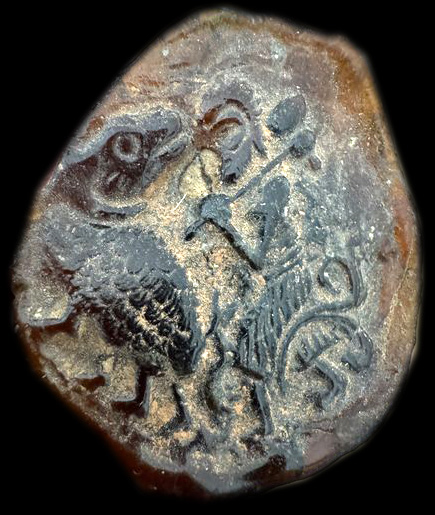
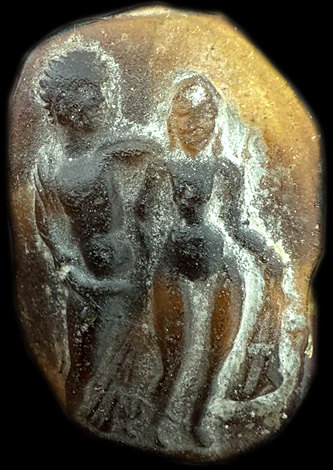
Bactrian Greek theatre tickets in molded
glass.
The First Ticket portrays an offering scene. It features a ram,
followed closely by a man with an axe, both positioned on the
medallion's rim. The man wears a primitive sheepskin skirt,
indicating a ritualistic context. This scene parallels ancient
Greek practices where blood sacrifices revitalized the dead,
akin to a scene in "The Odyssey" where Odysseus seeks wisdom
from the deceased seer Tiresias.
The Second Ticket: Commonly found on "cosmetic palettes" (whose
original purpose is unclear), this scene depicts a woman
revealing herself to a man or vice versa. It seems to be a
variant of the "woman in the window" motif, reminiscent of the
Jezebel story.
This suggests a theme of seduction or revelation, prevalent in
ancient storytelling and theatrical traditions.
These interpretations align these artifacts with known cultural
and religious practices from the ancient world, illustrating a
blend of mundane and spiritual themes in the art of the period. The style and imagery suggest a
cultural blend, as theatrical performances were a significant
part of Greek culture, and this tradition could have been merged
with local Bactrian storytelling and religious narratives.
This cultural blend extended to
religious art, where
Greek methods of sculpting in stone evolved into the use of
stucco. This medium allowed for greater expression of
individuality, a value cherished in both the Ptolemaic and
Seleucid kingdoms. Unfortunately, many stucco artifacts,
particularly in Afghanistan, have been lost to religious
extremism, but their discovery points to a rich legacy of
Hellenistic artistic expression in the region.
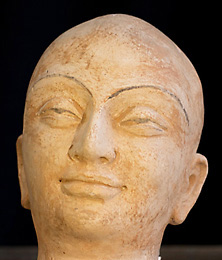
This stucco portrait of a Buddhist monk
represents a fusion of Hellenistic and Buddhist artistic
traditions. The asymmetry of the lips and the interplay between
sensuality and introspection suggest a personalized expression
of individuality. Departing from the stylized norms of later
Buddhist art, the precision in facial features here captures a
unique personality. The monk's closed eyes and the tranquil
asymmetry of the face evoke a meditative state. Skilled in Greek
realism, the artisans have rendered a piece that conveys the
spiritual essence of Buddhist thought through a distinctly human
portrayal. This sculpture serves as a profound example of the
cultural and artistic interchanges between the Hellenistic and
Buddhist worlds.
The cultural and commercial compass of Alexander’s new
city-states was, as already mentioned, linked like pearls in a
necklace stretching from Northern India to the Mediterranean
lands and Greece.
This chain of interconnected cities facilitated the
Hellenization of not only the areas around them but also the
cultures living along and within the caravan trails.
Through these cities, metaphorically seen as incubators of
foreign culture, India was 'infected' by the Greek 'virus.'
However, the influence also flowed in the opposite direction, as
was evident in Alexander's own lifestyle, especially after
conquering Persia. Even his most loyal, particularly the older,
generals criticized him for increasingly adopting foreign
customs, thereby distancing himself from his Macedonian roots.
Alexander, like many conquerors before and after him, became
enamored with the lands he conquered. The only one of his
generals to take up this tradition and even evolve it was
Seleucus Nicator.
As we will see in the following sections, the message of Ashokan
Buddhism could spread so far west precisely because of the trade
and cultural routes established by Alexandrian Hellenism.
Simultaneously, Greek mathematics, art, culture, and
particularly logical philosophy flowed eastward toward India,
becoming crucial to the construction of Buddhism in the
centuries before and after the Common Era. In this process, the
Eastern and Western cultural currents reshaped each other's
self-perceptions and expressions in an ongoing dialogue until
the Hunnic invasions in the 5th century AD and later Islamic
invasions.
BUDDHA GAINS A GREEK PERSONA
Indeed, when considering the development of Ashoka-Buddhism,
one must acknowledge the significant Hellenistic influences that
flowed from the Seleucid and subsequent
Greco-Bactrian and
Indo-Greek cultures. Caravanic communication, much like a
two-lane road, allowed for the exchange of ideas and cultural
practices in both directions. It was not Indians but rather the
Greeks who fashioned the earliest statues of the Buddha. These
figures were draped not in traditional Indian garb but in the
Greek himation,
underscoring the profound Hellenistic impact on Buddhist
iconography.
The Greek influence on Buddhism is thus hidden in plain sight.
It is subtly embedded within its very iconography. While
scholars with a focus on national narratives may acknowledge the
Hellenistic aesthetic of the Buddha's depictions, they often
understate the depth of Greek philosophical impact that
accompanies the folds of the himation.
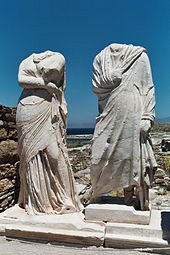
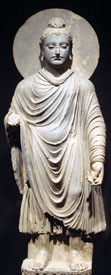
Left: Himation dressed statues from the House of
Cleopatra Delos, Greece (Wikipedia)
Right: Gandharan Buddha
The sartorial details of the
Buddha statues are not merely artistic choices; they are
vestiges of a profound intellectual exchange between Greek and
Buddhist thought, manifesting in a visual form that has become
emblematic of Buddhist art. The synthesis of Greek artistic
techniques with Buddhist symbolism gave birth to a unique style
of statuary known as
Greco-Buddhist art
and the later
Kushan-Gandharan art.
The creation of these statues marks a significant evolution in
Buddhist art, representing a shift from aniconic
representations, such as footprints or the Bodhi tree, to
anthropomorphic depictions of the Buddha. This evolution was not
just an artistic development but also a reflection of the
growing exchange of ideas and religious practices along the
trade routes connecting the East and West.
The Artistic Fusion of Hellenistic Influence and Buddhist
Statuary
The aesthetic characteristics of these Buddhist statues,
with their undulating hair reminiscent of Greek deities and
their tranquil, contemplative visages, bear the hallmarks of the
Hellenistic sculptural tradition, tracing back to archaic period
masterpieces like the statues of
Cleobis and Biton. This artistic exchange played a pivotal
role in propagating Buddhism into areas steeped in Greek
culture, thereby easing the faith's assimilation and acceptance
across new territories.
Thus, the creation of the first Buddha statues is a testament to
the enduring legacy of the interactions between Ashoka's India
and the Hellenistic kingdoms that arose from Alexander's
conquests. The aesthetic and philosophical exchanges along these
routes enriched both the Greek and Buddhist traditions, leading
to lasting artistic legacies that continue to be admired to this
day.
In essence, the familiar
representation of the Buddha—with the serene expression and
stylized drapery reminiscent of Greek sculpture—owes much to
this intercultural dialogue. The Greek artisans, interacting
with Buddhist concepts, interpreted the Buddha's image through
their own artistic lens, giving rise to the depictions that have
become widely recognized today. Thus, the Buddha's image as
commonly known now is indeed significantly shaped by Greek
artistic conventions. In fact, the Greek introduced to the East
the idea of individuality.
In this way the Ashokan mission disseminated a unique synthesis
of Buddhism, Hellenism, and Persian thought throughout the
empire and beyond. Boundaries between faith, art and ordinary
life became fluid, creating a rich, multi-cultural tapestry
along established trade routes.
The Great Wheel Expansion of the Greek Buddha
As Buddhism began to wane in India, its land of origin, it
found new vigor and sanctuary in adjacent regions such as Sri
Lanka, Tibet, China, Burma (Myanmar, and Thailand, where it
took root and flourished.
Amidst the fervent spread of missionary work, Ashokan
Buddhism—already established in various regions—took on a
renewed focus centered upon the figure of the Buddha. In this
era, Buddhism, particularly the
Mahayana or
'Great Vehicle' tradition, evolved into a diverse practice
that harmonized the popular, devotional worship of the Buddha
with sophisticated, philosophical thought. Mahayana Buddhism, in
particular, revered the Buddha as a divine being in human guise,
epitomizing him as an embodiment of inner beauty and grace, akin
to the aesthetic ideals of the Greek sculptural heritage. This
portrayal echoed the transformation of the
Hellenistic-Egyptian-Persian archetype of the divine warrior,
exemplified by Alexander, into the image of the tranquil ascetic
Buddha known today. This metamorphosis paralleled the profound
journey of Ashoka himself, who underwent a transformation from a
fierce warrior king to a devout renunciate, reflecting a
spiritual evolution both personal and cultural.
The anthropomorphic conception of divinity from Alexander's
Hellenism was, in a sense, a regression compared to the more
abstract religious notion of nirvana originally espoused by the
Brahmins and Buddha, which did not emphasize the body as a
religious message in itself. However, the anthropomorphization
of Buddha into the beautiful form of Greek statues helped
Mahayana Buddhism become a popular religion.
The emergence of the "Wheel of Dharma" Buddhism, with its
altruistic worldview was, with its logic and down-to-earth
approach, most probably a result of a synthesis of Seleucid and
later Bactrian-Greek rationality and Indian spirituality.
Greek Buddhism versus Hinduism
Many years ago, when I visited the predominantly Buddhist
rock-cut caves of Ajanta and Ellora (200 BCE to 600 CE) in
India, the contrast between the Buddhist and Hindu caves was
striking. Although the Buddhist caves displayed more Apollonian
restraint compared to the Dionysian diversity of gods in the
Hindu caves, this impression turned on its head upon entering
the inner sanctum. Inside the Buddhist caves, at the holiest
core, stood a statue of the Greek Buddha as an Alexander in
divinized human form. In contrast, the Hindu temples, which
began like a visit to Disneyland, culminated in an utterly empty
space in the inner sanctuum.
The notion of god in human form, where the human figure itself
could represent the divine logos, was widely accepted within the
pan-Hellenistic cultural sphere. However, this anthropomorphic
concept was unfamiliar in India before Alexander's invasion. The
Brahmins,
according to historical accounts, vigorously debated this
subject with Alexander and his philosophers. The Brahmins'
abstract conception of god as the transcendent principle of
Brahman was incompatible with the Greek ideal of a beautiful
soul in a beautiful body.
Clan-solidarity versus Universal brotherhood
Larger states, in their consolidation phase, typically
prioritize peaceful coexistence among diverse peoples and
cultures. Such states differ from smaller clan-based states in
that they foster a sense of brotherhood among people from
different backgrounds without relying heavily on military
dominance.
While pre-Buddhist religions, like Judaism, also teach goodness
and love, it's the unconditional, pan-humanistic love in
Buddhism and to some extent also Christianity that stands out.
It extends beyond clan consciousness, aiming to connect diverse
people through enlightened humanity.
One essential observation to note is the expansive cultural
reach of larger empires, extending well beyond their territorial
borders. These dominant civilizations are repositories of highly
sophisticated cultural and social knowledge, which is a critical
factor enabling them to succeed in wars and conquests. Take, for
example, Alexander the Great's military campaigns, particularly
in Persia. His advanced military organization and technology
acted akin to a viral pandemic, setting off a Darwinian
competition between cultures in a struggle for survival of the
fittest. Following the initial phase of warfare, a period of
peaceful adaptation often ensues within the newly conquered
territories. This process bears a striking resemblance to
evolutionary dynamics, where humans, over time, have learned to
coexist with and even benefit from the presence of bacteria and
viruses. The peaceful adaptation period allows for the
integration and assimilation of cultural, technological, and
social elements from the conquering empire, much like how humans
have developed symbiotic relationships with microorganisms.
In this way, the cultural and technological "viruses" that
empires spread as a general rule leads to periods of adaptation
and even mutual benefit. The spread of culture, then, is not
merely an act of imposition but also one of complex, often
reciprocal, exchange and adaptation, even to the point where the
conquered civilization exerts cultural influence over its
conqueror.
A latin quote from Horace's "Epistulae II. i. 156" beautifully
encapsulates this phenomenon. In this case, Greece, after being
conquered, managed to "capture" Rome by infusing it with its
art, culture, and wisdom.
"Graecia capta ferum victorem
cepit et artes intulit agresti Latio."
(Conquered Greece
conquered her savage conqueror
and brought the arts into rustic Latium.)
Jesus in the East
As we reflect on the cultural exchanges of antiquity, it is
evident that Christianity, like Buddhism, traversed great
distances. This stucco head from Bactria may indeed represent an
Eastern depiction of Jesus, resembling a Greek philosopher. The
detailed rendering of a crown of thorns, coupled with the visage
marked by affliction, strongly suggests a Hellenistic
interpretation of the Christian savior. Such an artifact could
signify the mutual influence of Eastern and Western spiritual
traditions, perhaps even influencing the development of Mahayana
Buddhism's Great Wheel.
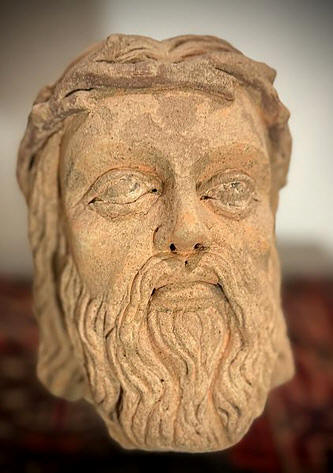
This stucco head from Bactria, interpreted as
a birded representation of Jesus Christ, reflects a synthesis of Greek
and Christian iconography. The crown, resembling a wreath, and
the expressive face marked by lines of suffering, align with
traditional portrayals of Jesus in Christian art, particularly
emphasizing his passion and crucifixion. The execution of the
sculpture, with its detailed beard and contemplative gaze,
echoes the style of Greek philosopher portraits, suggesting an
intent to depict Jesus within this philosophical tradition. This
artifact underscores the spread of Christianity into the East,
and illustrates the cultural dialogues between Hellenistic art
and early Christian symbolism. The use of stucco for
iconographic purposes in the Bactrian region likely peaked
during the early centuries AD, influenced by Hellenistic
traditions. Given that this artistic medium and the portrayal of
religious figures in such a manner were not common beyond the
4rd century AD, this artifact could be among the initial
attempts to visually represent Jesus, merging Hellenistic
artistic styles with the emergent iconography of Christianity as
it spread eastward. The emphasis on the human aspect of Jesus in
the stucco head might suggest an influence from early
Dyophysite
Christianity, which asserts the dual nature of Christ as
both fully divine and fully human. This theological stance was a
central aspect of the Chalcedonian Creed established in the 5th
century. The representation of Jesus with a strong human
likeness, as seen in the stucco head, aligns with Dyophysite
thought, emphasizing that while Jesus was divine, his human
experiences, emotions, and sufferings were also very real. This
could reflect the cultural and theological exchanges between
East and West, where Eastern Christianity, particularly in
regions like Syria, had significant interactions with
Hellenistic cultures that might have influenced religious art
and iconography.
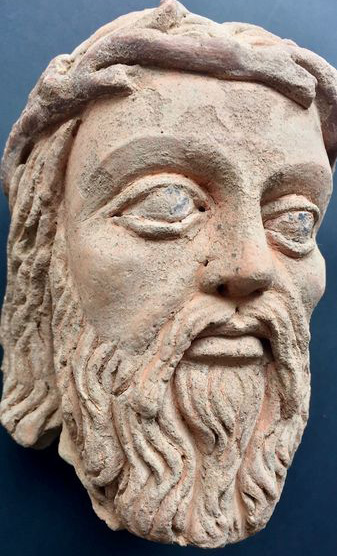
This image of the Bactrian stucco head,
captured from a different angle, clearly reveals that the head
ornament comprises thorns, not flowers. This detail
significantly alters the interpretation of the sculpture,
aligning it more closely with traditional Christian depictions
of Jesus Christ, particularly referencing the crown of thorns
associated with his crucifixion.
According to professor Diamaid Mc
Culloch in
A History of Christianity, were it not for the Islamic
invasions, the center of Christianity would not be Rome and/or
Constantinoble, but much farther Eastwards like Baghdad.
Christianity
was like Buddhism on a mission
and it went as far as China.
BUDDHA AND JESUS: BILBOARDS FOR
WANDERING NARRATIVES
In summary the Silk Roads transcended their role as mere
conduits of commerce, acting as vital conduits for cultural
exchange. These routes allowed for the intermingling and
transformation of wisdom, narratives, and collective experiences
among civilizations. As illustrated earlier, the Buddhist Jataka
tales, initially spread through oral traditions, evolved and
integrated into global literary treasures such as the Persian "One
Thousand and One Nights," eventually permeating European
culture. This narrative exchange, akin to the movement of
currency, signifies the profound interconnectedness fostered by
the Silk Roads, blending the material with the intellectual and
spiritual.
Famous persons are both
symbolic repositories and historical figures
Examining the New Testament’s depiction of Jesus, we encounter
two distinct portrayals: one is a more confrontational figure,
while the other embodies non-violence and forgiveness. The
grafting of narratives onto a local figure doesn't always
seamlessly align with the individual's character, suggesting a
historical basis for Jesus. The discrepancies in these stories
indicate the layers of narrative added over time, pointing to
Jesus as a tangible historical figure.
States, religious bodies and scholarly traditions mirror oral
storytelling, perpetuating wisdom by weaving widespread tales,
myths, and motifs.
Jesus, historically and presently, has been molded by church
authorities, blending external influences with local narratives.
This process incorporates 'good'—or pedagogically potent—stories
from various sources.
The constructed nature of Jesus and Buddha does not diminish
their reality; social construction is what defines reality.
Jesus and Buddha serve as focal points for collective wisdom,
akin to billboards for wandering narratives, capturing
historical, political, and cultural insights. Thus, they are
both symbolic repositories and historical figures.
In the extensive cultural fusion between East and West, it's
reductive to view Christianity simply as a copy of Buddhism.
German scholar
Burkhard Scherer acknowledges the presence of "much Buddhist
stuff" in the Gospel, but clarifies that it's not the sole or
even primary source for the New Testament.
Christianity stands as a significant Western creation of
civilizational self-control, where Buddhism is not the only
influence. Yet, examining abstract social behaviors, we see the
East's early development of religious self-control, predating
Western equivalents. This influence transcends language, with
pre-linguistic, embodied interactions impacting cross-cultural
exchanges. The concepts of goodness and forgiveness, rooted in
embodied practices, originated in the East, specifically on the
Gangetic plains, long before they found expression in the Jewish-Roman
context that birthed Christianity.
Every culture is
essentially a creative blend of influences from others, a
reality that applies to all religions and social phenomena.
However, interpreting these cultural exchanges purely through
the lens of power dynamics, as often done by scholars influenced
by Foucault's postmodernist ideas, suggests a problematic
simplification in academic thought. In this context, postmodern
'wokism' can be likened to a form of religious belief, similar
to how
scholars with strong religious convictions might study religion.
This approach tends to ignore the complex nature of cultural
interactions, which involve much more than power and religious
biases. They also include shared technology, cultural knowledge,
mutual understanding, and cooperative development.
We are now ready for the next chapter,
Civilization and Consciousness
Part II, where we will zoom out and return to the main theme
of this exploration: consciousness.
Moving forward, we will embark on
Civilization and
Consciousness Part II
pivoting back to our core inquiry: the enigmatic nature of
consciousness. This next chapter will broaden our perspective,
offering a deeper understanding of consciousness within the
tapestry of civilization.
EPILOGUE OF A DREAM -
The Indo-Greek Genesis of Nothing
The decimal system, often misattributed as Arabic, was
in fact a seminal Indian invention, with the concept of zero
representing a significant intellectual leap. The Hindi term for
zero, "shunya," denoting emptiness, echoes the profound
philosophical traditions of India where the notion of void is
pivotal.
It’s noteworthy that the Hindi word for zero, "shunya," is a
religious term for emptiness, likely influenced by the Indian
religious philosophy where voidness plays a crucial role across
Hindu Brahmanism, Jainism, and Buddhism. The concept of zero, or
nirvana in Buddhism, can be seen as an extension of this
mathematical void.
In Western thought, arising from ancient Greece's denial of
zero, consciousness is often misconstrued as something tangible.
This search for the concrete overshadows the appreciation of
'nothingness.' In Indian culture, being called a 'zero' could be
a compliment, reflecting a state of supreme emptiness as
extolled by sages like Ramana Maharshi, known as the Great
Emptiness.
The philosophers accompanying Alexander the Great to India
encountered Indian sages adept in philosophical discourse, yet
the Western acknowledgment of foreign cultural contributions to
our own has been limited.
Zero first graphically appeared on a temple in Gwalior, India,
in 876 AD.

Number 0 from a temple wall in Gwalior
Photo from an article in The Guardian
The philosophical
concept of emptiness, pivotal to Eastern thought, likely evolved
through East-West dialogues during the Hellenistic period. It is
plausible that Indian Buddhist monks, educated in Greek thought,
formulated the idea of zero. The intellectual exchange catalyzed
by King Menander's adoption of Buddhism may have also introduced
these monks to Greek dialectics. This cross-pollination of ideas
could explain the logical and almost secular nature of Buddhism
as perceived in the West. The legacy of these dialogues
persists, notably in the
debate
practices of Tibetan monastic traditions.
This tradition of debate traces back to a protracted ideological
struggle where Buddhism faced resistance in India. During the
early centuries AD, as society saw a reassertion of Brahmanical
order, Buddhists engaged in intense public debates with Hindus.
As Will
Durant notes, these debates were so fervent that the loser
sometimes faced mortal consequences. Buddhists employed
Greek-influenced logic to advocate for anatman, the
non-existence of a permanent soul, while Advaita Vedanta Hindus
argued for the existence of an eternal essence, Atman/Brahman.
The notion that existence is "shunya" or emptiness, became a
central tenet of Buddhist philosophy with Nagarjuna, presenting
a stark contrast to Brahmanic traditions that emphasized a more
tangible ultimate reality. This philosophical divergence likely
played a role in the conceptual development of the mathematical
zero in India, a hypothesis that aligns with Occam's Razor—the
principle that the simplest explanation is often
correct—suggesting that zero emerged from these dynamic cultural
and philosophical exchanges.
The irony indeed is profound. The very foundations of Western
science and technology, which espouse a positivistic worldview,
owe a significant debt to the Indian concept of zero—a notion
conceived within a deeply religious context.
to be continued here:
Civilization and Consciousness
Part II
Sources
Seleukos Nikator,
Constructing a Hellenistic Kingdom - John D. Grainger
Bactria, The Histoty of a forgotten Empire - H. G.
Rawlingson
The Greek Experience of India - Richard Stoneman - 2019
Mauryan Empire - Irfan Habib & Vivekanand Jha
Alexander the Great - Robin Lane Fox
A History of Christianity - Diarmaid Mc Culloch
The Silk Roads - Peter Frankopan
Hellenism in ancient India - Bannerjee, Gauranga Nath
The Story of Civilization ( II to V) - Will Durant
The Art and Architecture of India
- 1996. B. Rowland
Buddha Statuen - Leonhard Adam -
1925
Buddha in Indien - Kunsthistorisches Museeum in Wien -
1995
The Jaina Path of Purification - Padmanabh S. Jaini
Collected Papers on Buddhist Studies - Padmanabh S. Jaini
Konge for en dag (King for a Day) - 1946 - Kaare Foss
Naked Philosophers: The Brahmans in the Alexander
- Richard Stoneman Historians
and the Alexander Romance - 1995 - Richard Stoneman
The Bible and the Buddhist
(Sardini, Bornato [Italy] 2001) Duncan McDerret:
An Intriguing but Isolated Figure:
Dr. Phil Christian
Lindtner
www.Jesusisbuddha.com
- curated by Dr. Phil Christian Lindtner
Dr. Christian Lindtner is a figure
who has stirred considerable controversy and, as a result, finds
himself on the periphery of mainstream academic discourse. His
theories, while unique, have been met with skepticism and are
often regarded as overly simplistic and speculative within
mainstream academic discourse.
Burkhard Scherer notes: CL here very dangerously deviates
from sound scholarship into the dungeons of half-insane
amateurism.
Furthermore, Lindtner, like many specialists, exhibit a certain
obliviousness to topics beyond his immediate expertise. For
instance, his assertion that Jesus was a non-historical figure,
used to underpin his theory that the New Testament is
essentially a reiteration of Buddhist scriptures, can be
challenged. The evolution and adaptation of the Jataka Tales
demonstrate the flaw in such a provocative claim. Stories and
myths evolve and transform as they traverse cultures. Upon
reaching new lands, they often become personalized, centering
around a local figure, thereby acquiring a unique, localized
expression. Thus, Christianity is not merely a facsimile of
Buddhism; rather, it has been profoundly influenced by Buddhist
teachings and adapted them within its own spiritual and cultural
framework.
More Controversial Yet
Thought-Provoking Sources:
While I recognize the following sources as inspirational, I
don't view them as entirely reliable for academic rigor:
Jesus Lived in India - Holger Kersten
Lost Years of Jesus - Elizabeth Clare Prophet
These sources and personal experiences while travelling for
years in India and Nepal, have contributed to my nuanced
understanding of the complex relationships between Eastern and
Western philosophies and religions.
Gunnar Mühlmann
|

